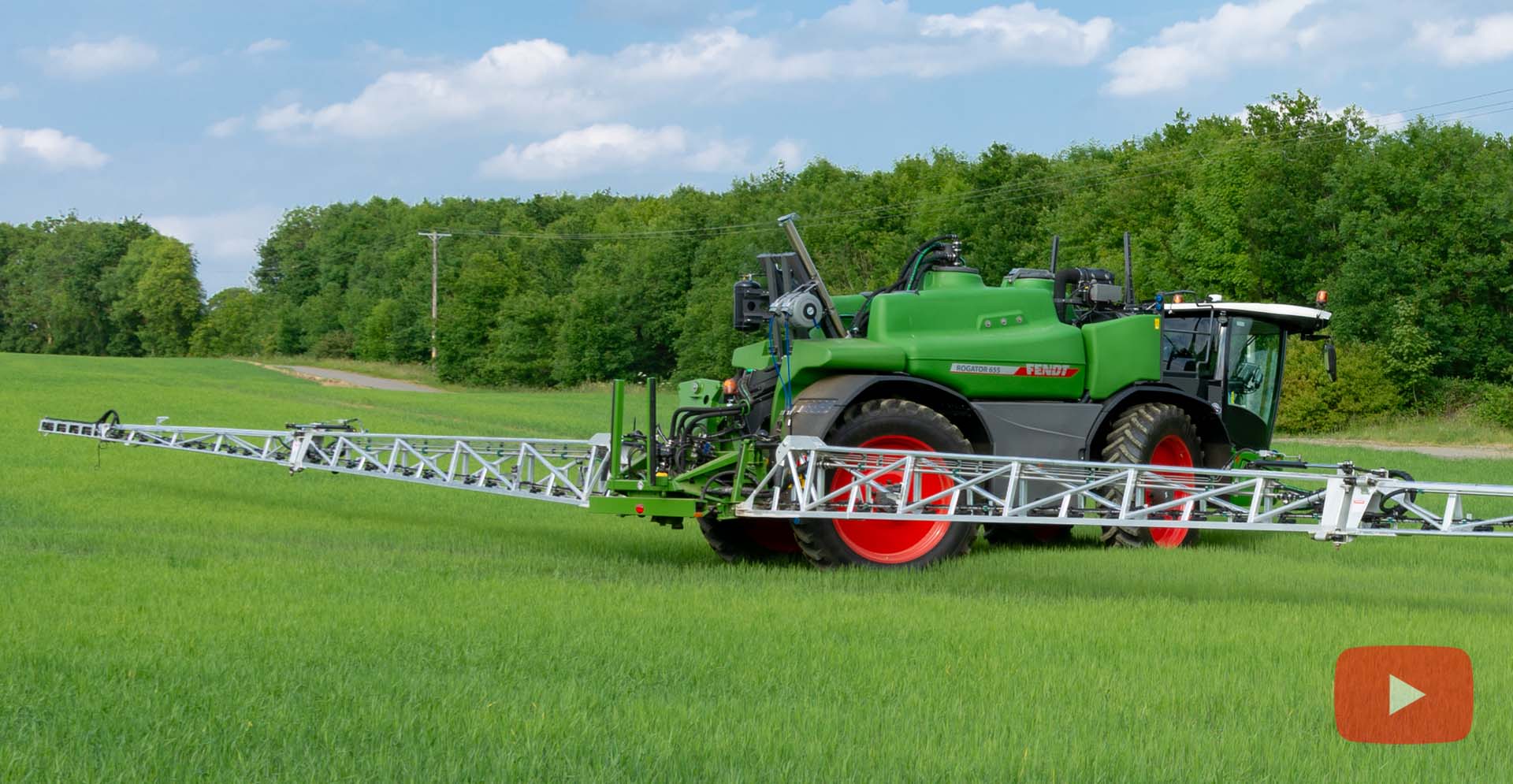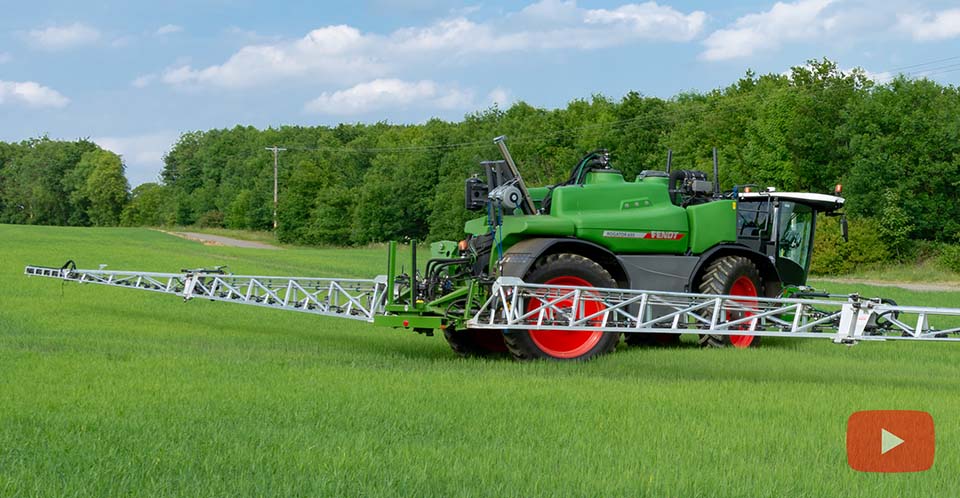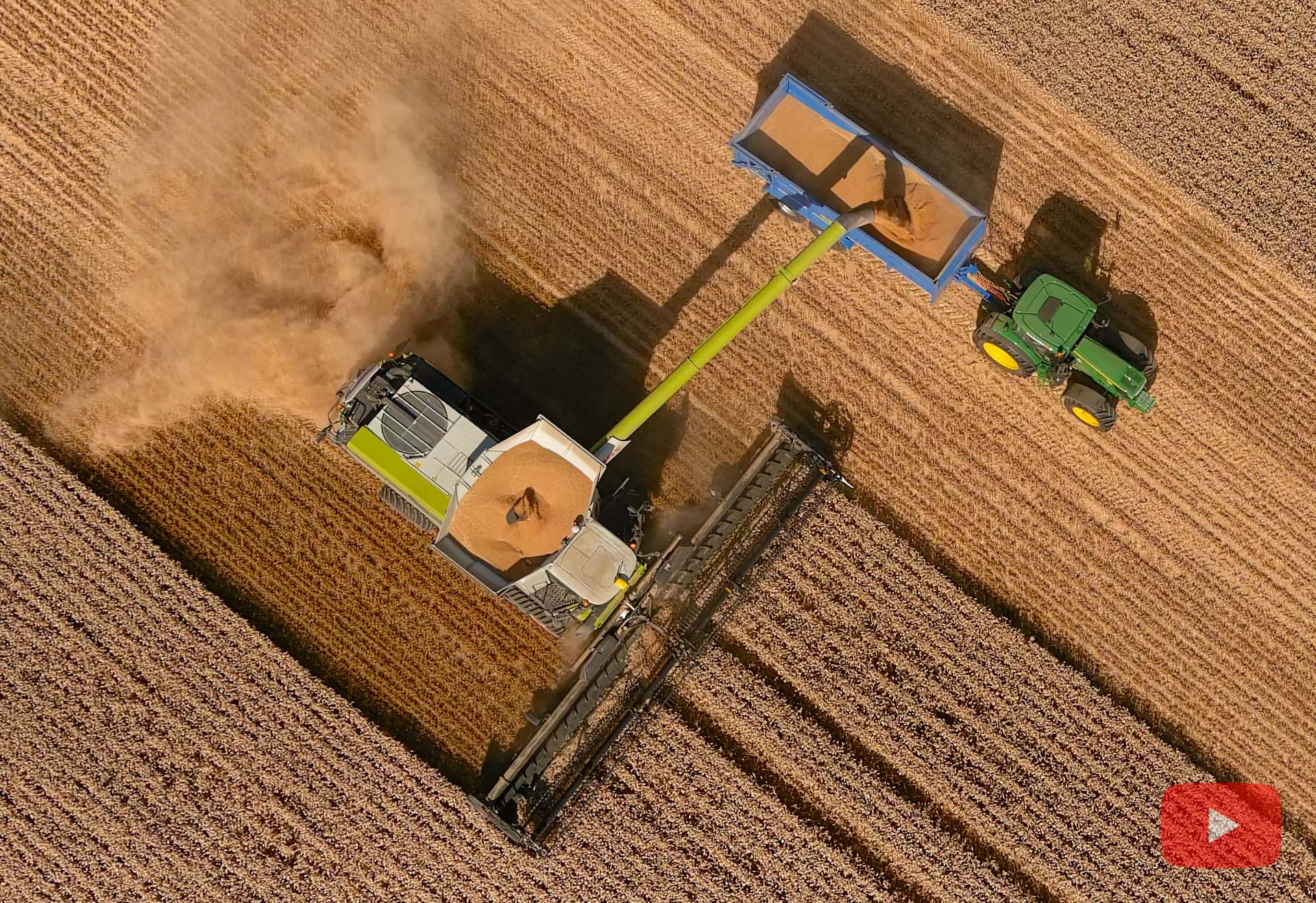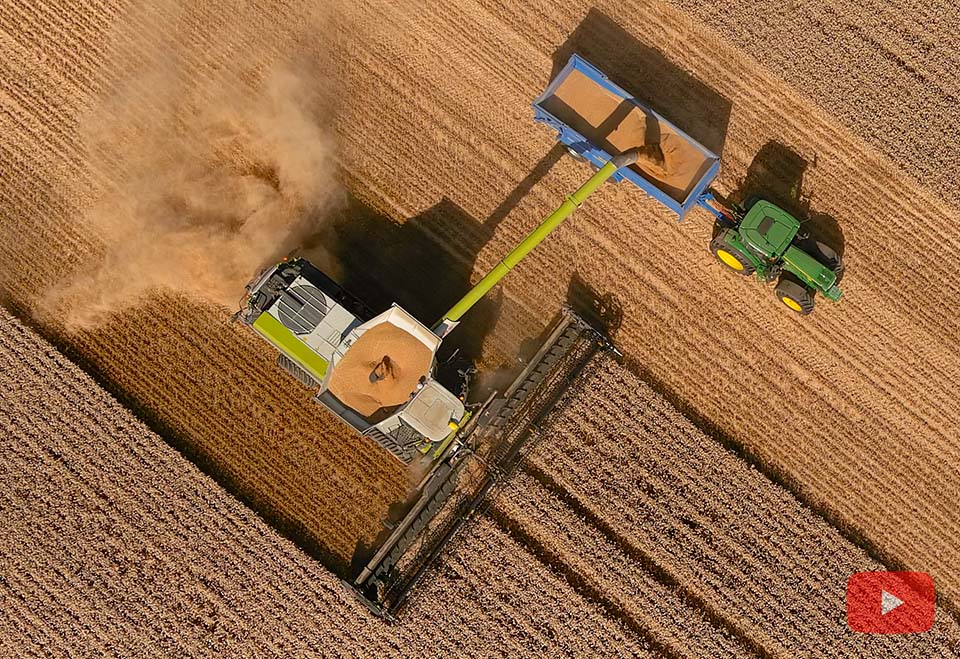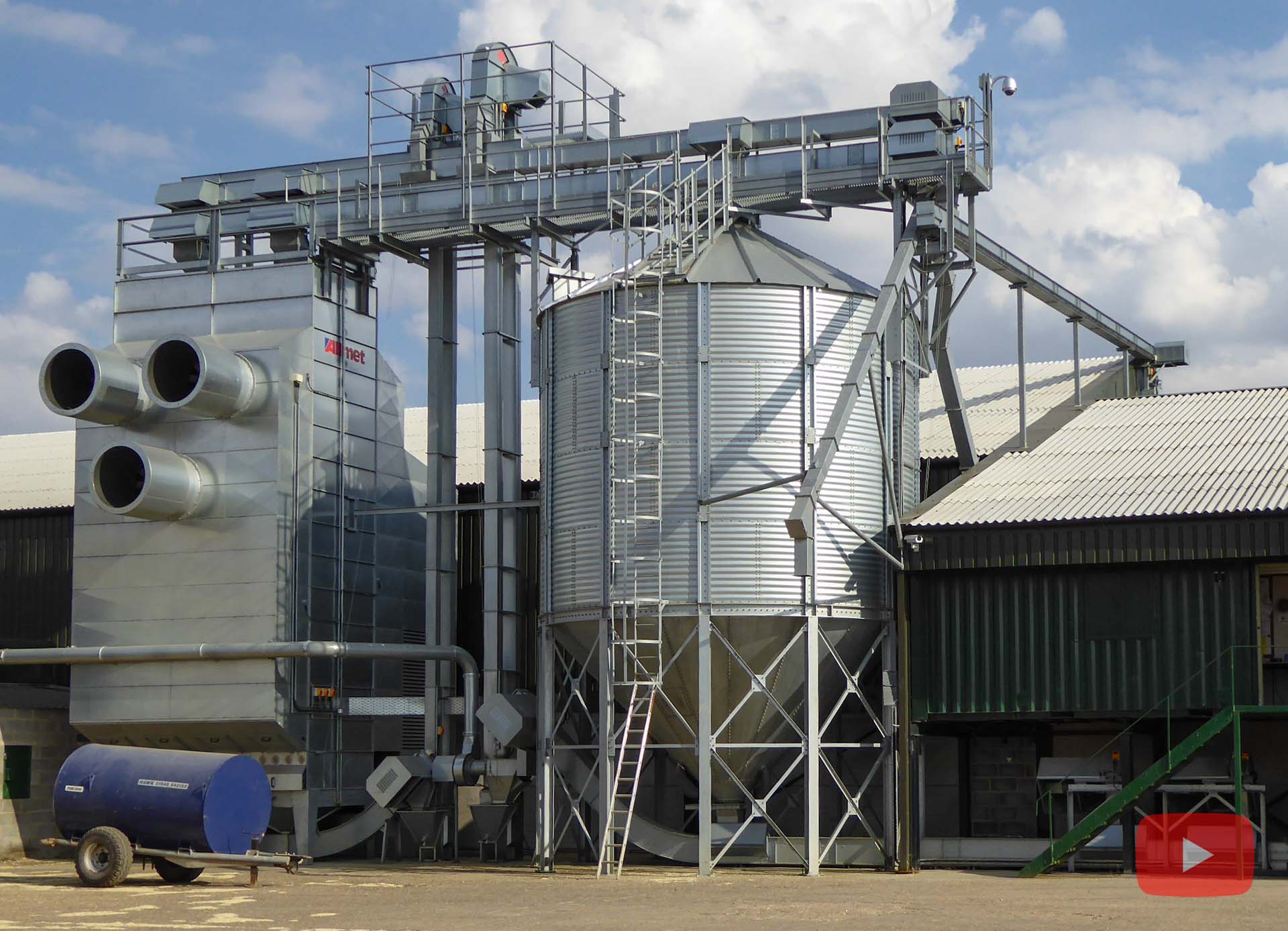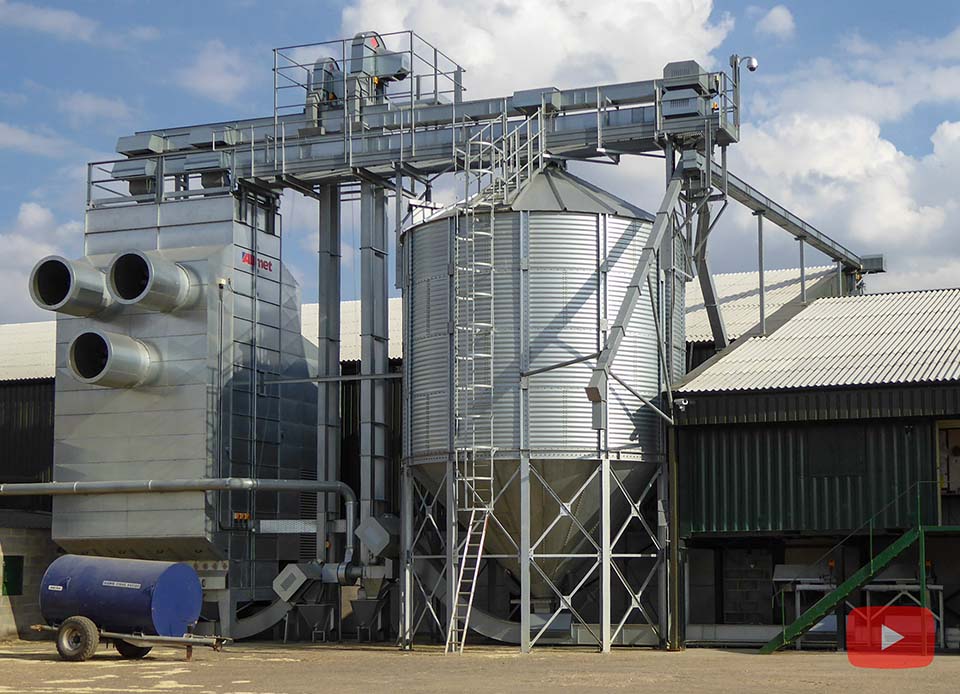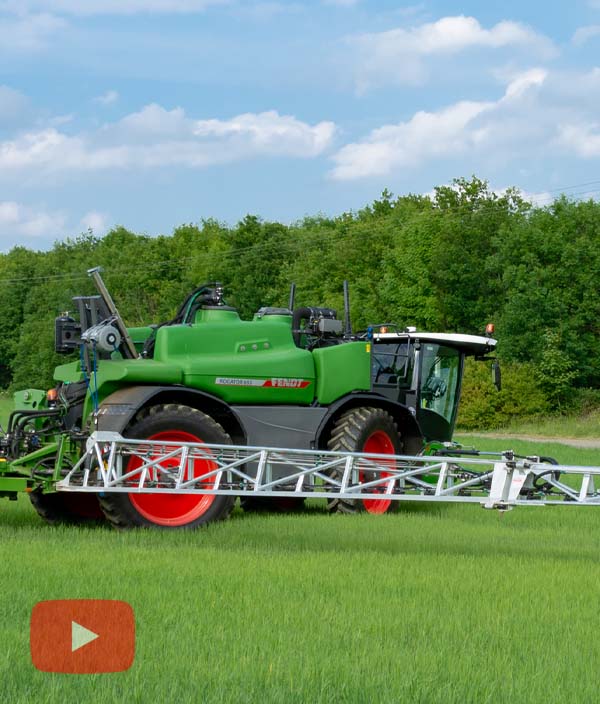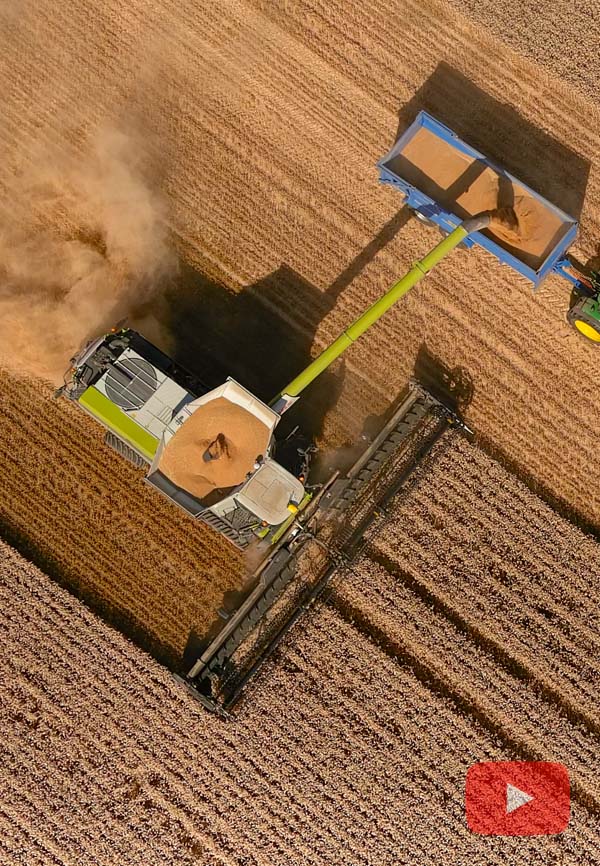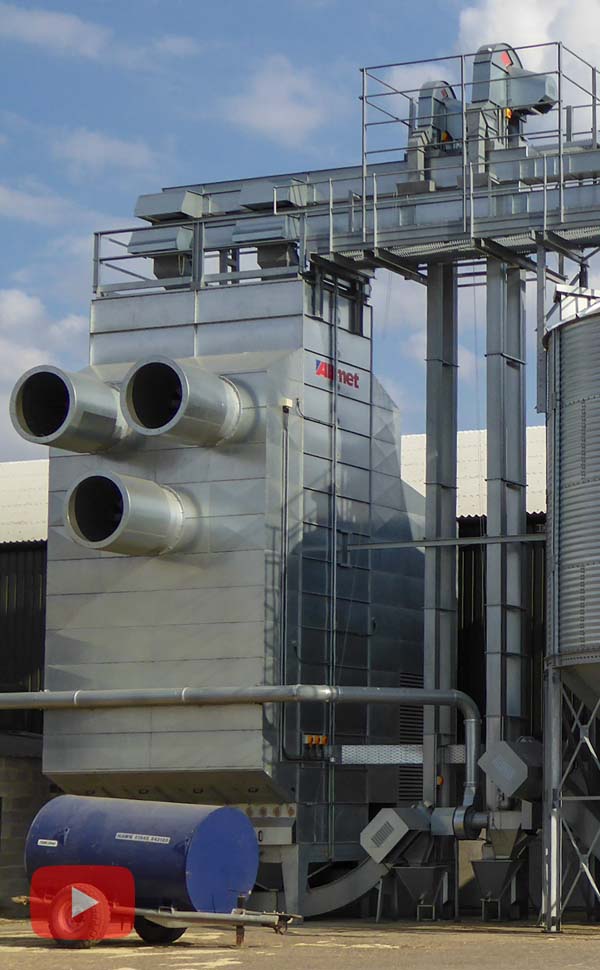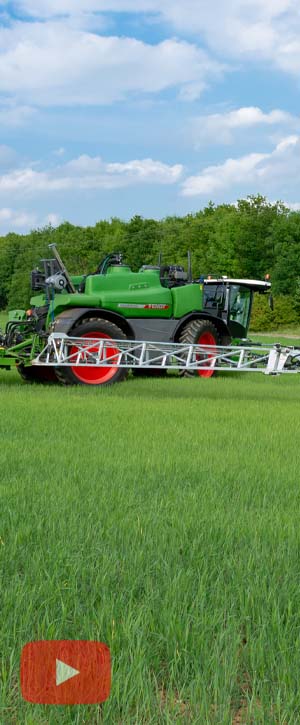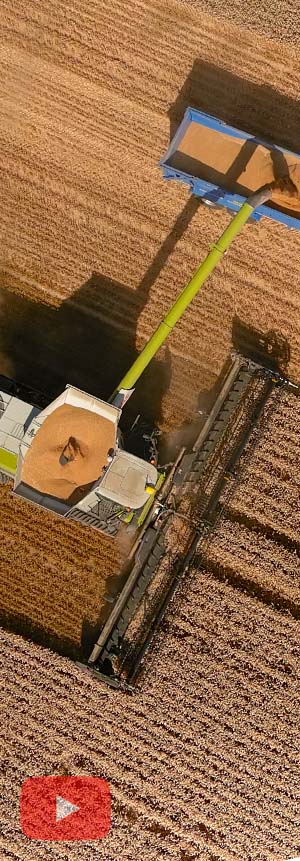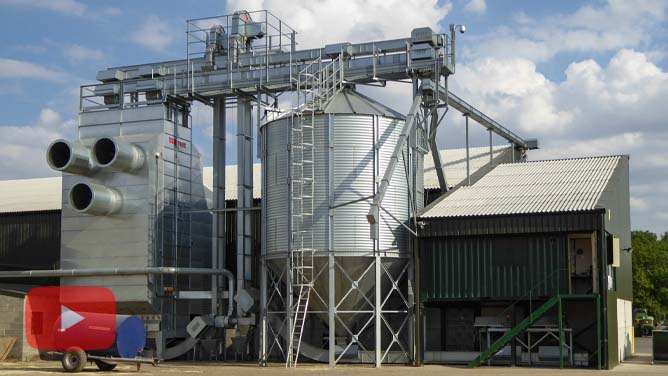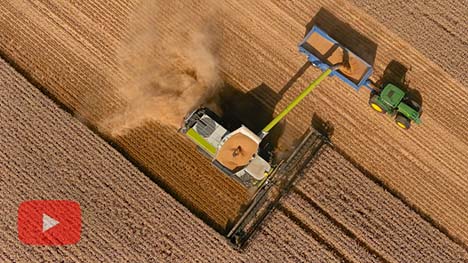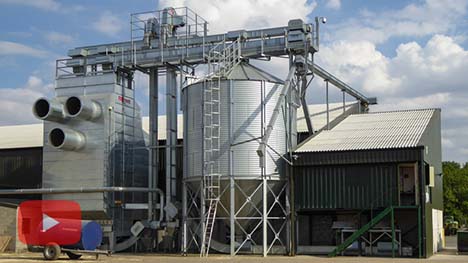
The Contract Farming Business - What We Do
Primarily, as a whole farm contracting business entrusted to manage extensive areas
of the countryside, Conant Farming recognises the responsibility for realising the
potential of all its land interests, and how operating sustainably protects the wider
environment, ultimately ensuring future generations remain able to produce crops.
Successful and profitable long-term partnerships are formed by appreciating the distinction
between different landowners and their respective settings, having a clear understanding
of any specific requirements and aspirations, and by always managing expectations.
CFCO formulates individually tailored contractor agreements from the outset. On the
ground, the team operates with universal attention to detail, getting the job done well.
Then, by holding regular landowner meetings, supporting open lines of communication,
consistently reporting against annual budgets and managing cashflows, customer
relationships build a natural mutual trust and resilience, enjoying success year-on-year.
CFCO farms for all landowners by…
Taking a sustainable approach.
Implementing regenerative farming.
Aiming for net zero.
Facilitating environmental income.
Operating effectively using technology.
Moving forwards, stronger together.
Crop Production - A Sustainable Approach
Conant Farming has lowered establishment costs by introducing regenerative
practices and implementing relevant environmental stewardship schemes. This
has maintained the profitable production of some great crops across the
contracted sites, whilst simultaneously enhancing soil health and reducing the
overall ecological impact. In short, farming smarter with a longer-term view.
It’s not always about realising the greatest earnings in the one perfect season, only
to suffer a wide variety of consequences in subsequent years. The aim instead is to
improve and support yields whilst concurrently decreasing production costs - not
just mechanically - but by comprehensively working with, and not against nature.
The farming industry must evolve to survive, moving away from intensive practices
to provide for the next generation. CFCO is already a leader in circularity, yet will
always consider new methodology aiming for improvements and efficiencies.
Regenerative Farming
A simple idea; recognising that everything a plant needs should be readily available in the soil.
Ideally, growing crops shouldn’t require cultivation, fertilisers or protection products.
By maintaining photosynthesising green cover year-round, including companion cropping where
appropriate, not only is the soil surface afforded protection, but all planting benefits from the
abundance of energy sequestered. It’s also vital to understand that life below ground is profiting from
this continuous growth cycle, almost beyond measure. Creating nutrient-rich well-structured ‘living’
soils 'alive' with microbiology often completely contrasts with the relentless rigors of intensive farming.
Holistically achieving a more innate resilience to crop disease, weed growth, and pest damage,
drastically reduces the need for synthetic inputs. By further increasing organic matter within the soil,
the overall ground structure, biodiversity and hydrological properties improve. This not only
promotes plant growth but also provides resilience against adverse weather conditions, and reduces
or even eliminates the need for heavy, costly and often ecologically damaging 'reset' cultivations.
It takes time for the positive regenerative effects to come to fruition, so Conant Farming aims to
strike a balance relative to the land conditions, customer expectations and shorter-term viability.
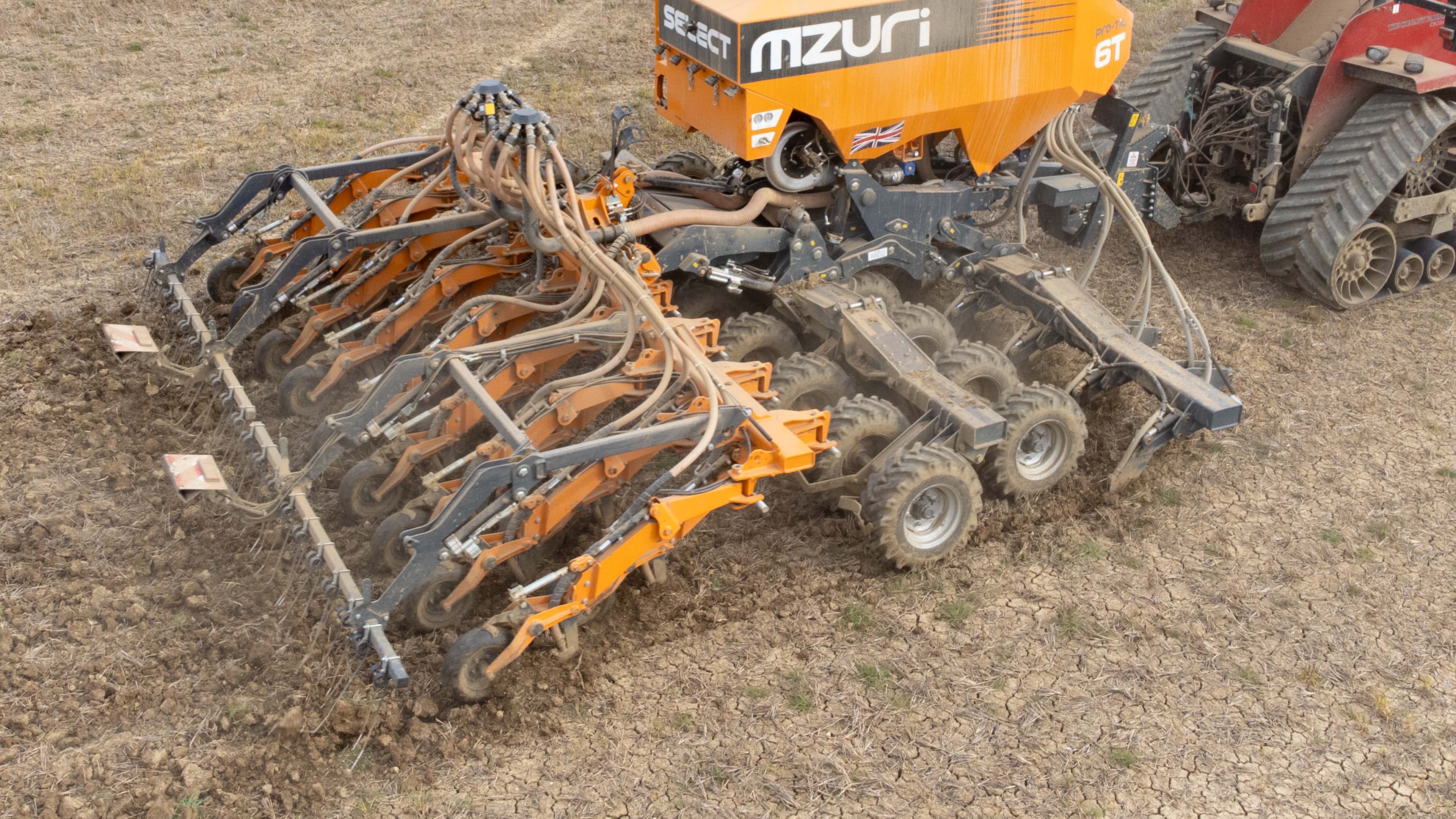
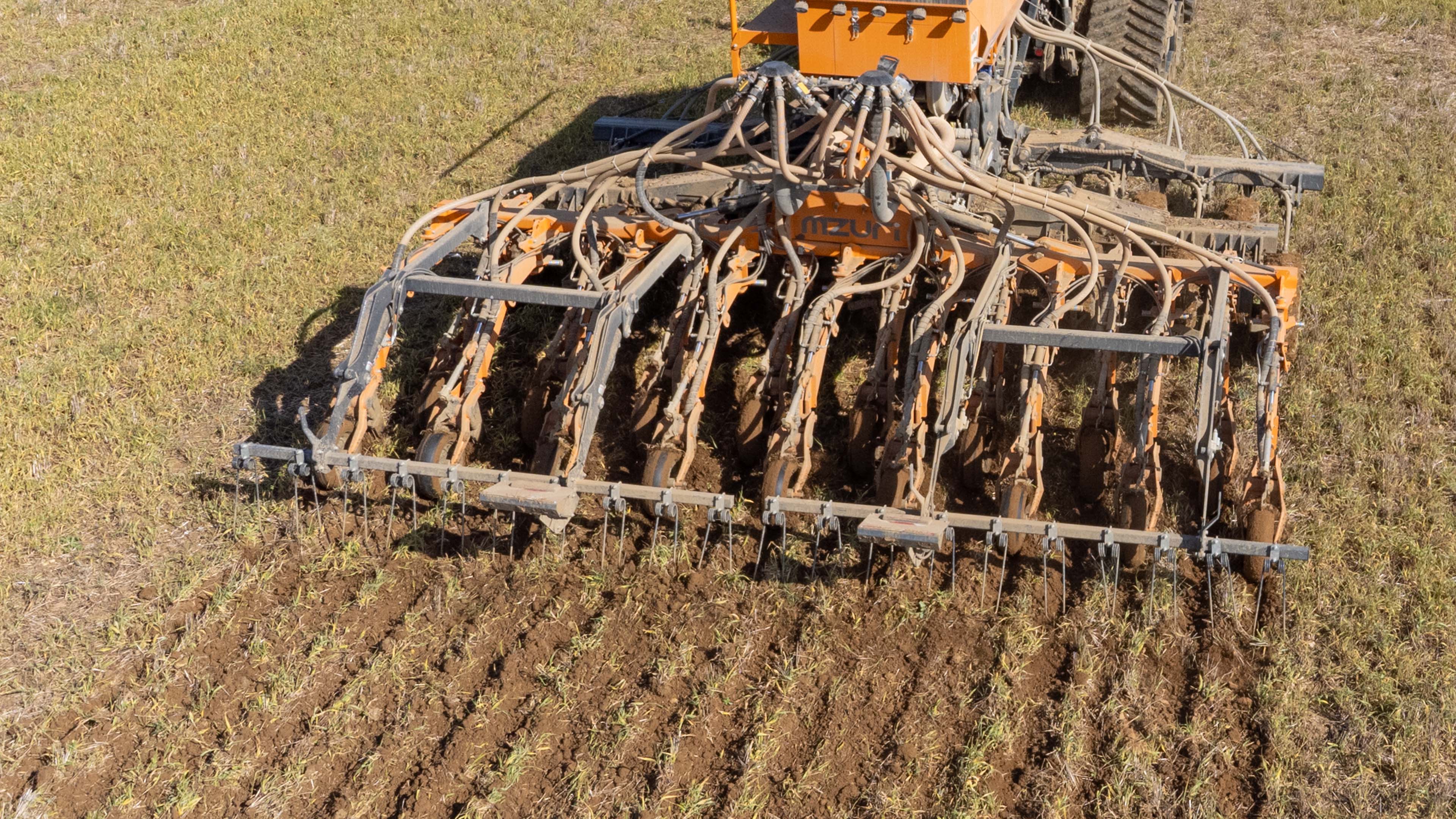
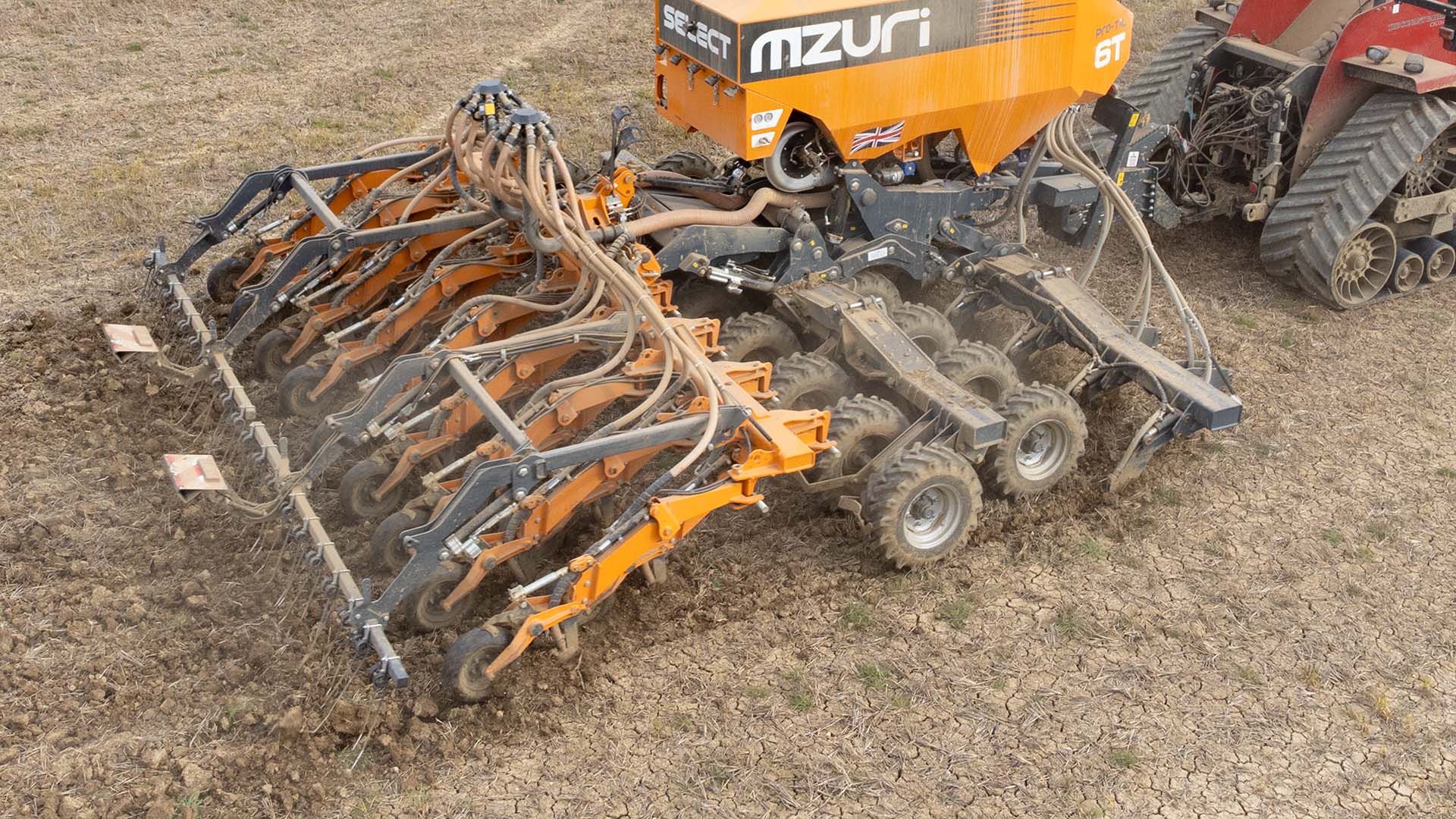
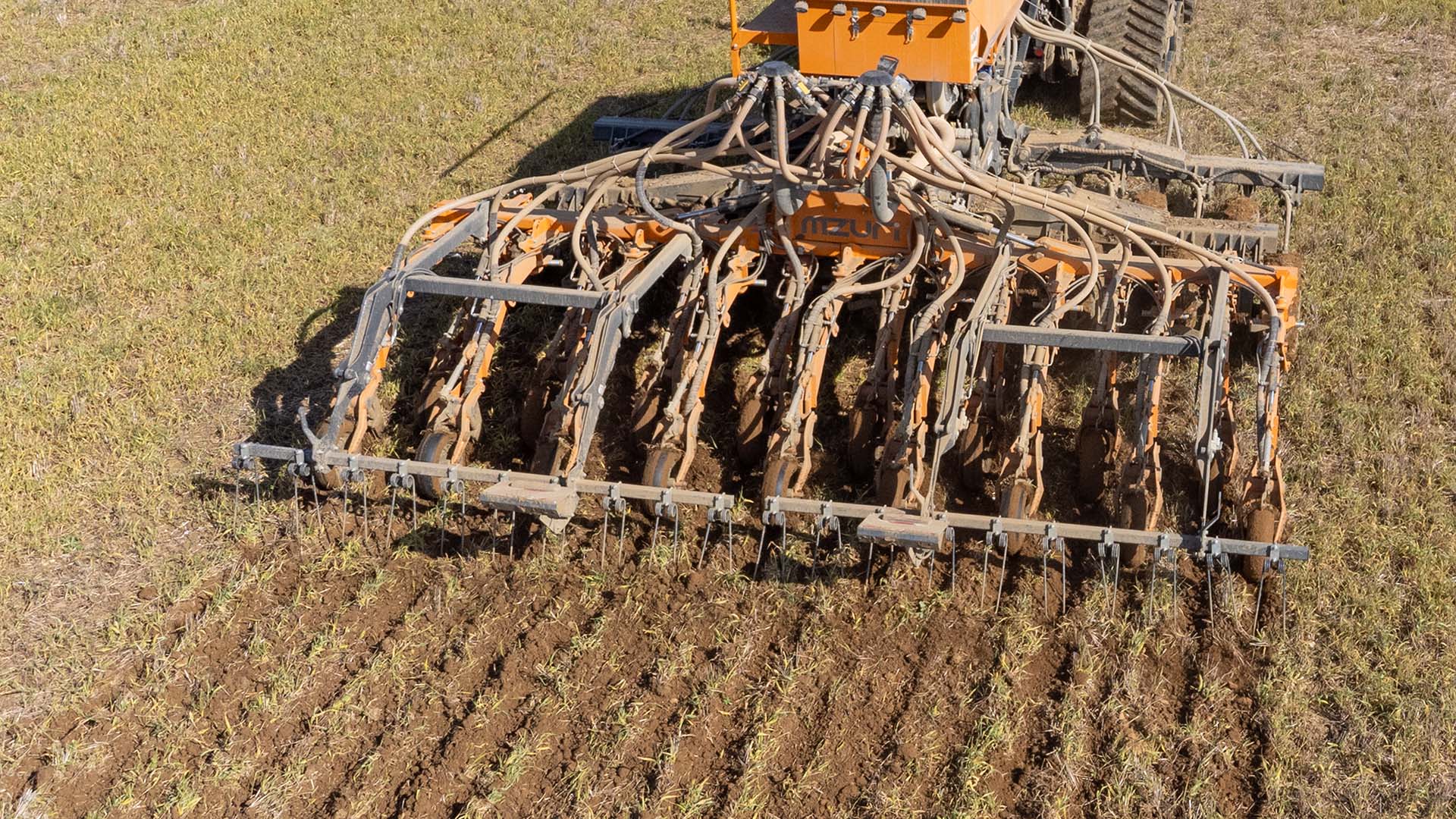
drilling into heavy clay land, taken on neighbouring plots at
Lyndon. Post harvest, one field remained as bare stubble whilst
the other had green cover planted immediately afterwards.

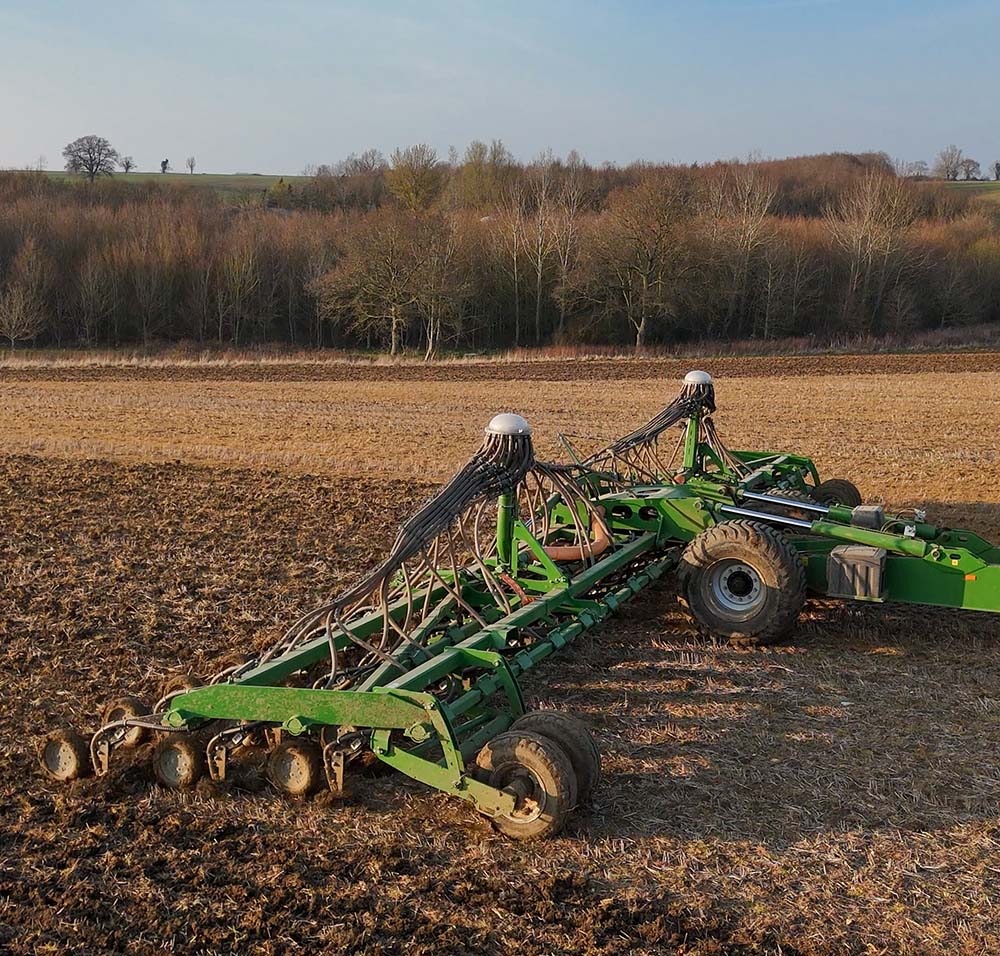
Aiming for Net Zero
With the clock ticking towards the point where the world must achieve net zero,
many industries are now looking to, or legally must, offset their greenhouse gas
emissions where it is otherwise not possible to do so. According to the NFU, the
aim is for agriculture (in England & Wales) to meet this target by 2040.
Switching from an intensive cropping regime and implementing Conant Farming's
already well-established regenerative approaches, allows landowners to reduce their
carbon footprint, improve soil health, and increase the carbon sequester (storing
more carbon in the soil than is emitted). Then, adopting a measured carbon capture
project may help build a more sustainable business model with the landowner
receiving tradeable credits for the carbon stored within their surplus capacity.
Some caution should be afforded given the relative infancy of carbon credit
trading. Expert advice must be sought, particularly as these schemes involve a
long-term commitment where a predetermined ‘capture period’ is followed by a
further duration of ‘permanence’ to prevent carbon dioxide getting released back
into the atmosphere. It should also be noted that payments result from the
additional carbon captured (measured annually), amounts which will naturally
subside in the approach to saturation - at this stage nobody really knows how far
organic matter increases can be driven. The scope for carbon storage also varies
from farm to farm, but many businesses globally are already taking advantage.
Whatever your view on decarbonisation, this is certainly something to consider.
CFCO is equipped and ready to help landowners achieve project targets.
Facilitating Environmental Income
Post Brexit, the farming industry lost direct subsidies. Headlines like ‘public money
for public good’ placed the spotlight on domestic food production. Despite all the
publicity, and the magnificent work that organisations such as LEAF (which CFCO
is a member) do promoting and educating through their labelling and running of
events such as Open Farm Sunday, was it enough to justify further funding?
DEFRA's Environmental Land Management (ELM) schemes aim to offer
additional income to underpin domestic food security. Yet to appease the voters
and steer policy, the support is effectively ‘sold’ to landowners, provided in return
for making enhancements to often already professionally managed, wildlife-rich &
diverse farmland. But it’s ironic that the earnings do not physically contribute to
producing cash crops or offer much to address the viability of farming! In fact,
worryingly, a fair chunk of the population has a lack of awareness when it comes
to primary food production or that the UK is only about 60% self-sufficient.
However, by taking part in a variety of these diverse Government schemes since
inception, many important actions have been implemented; improving soil health,
nutrient management, and pest control. Reducing water pollution risk and
regulating atmospheric emissions are other focal points of the ELM policies.
Conant Farming is well-placed to intelligently advise, design and effect any SFI
(Sustainable Farming Incentive) and CS (Countryside Stewardship) agreements, or
any such future ‘safety net’ the Whitehall Legislators formulate to 'mitigate' the
financial disparities relating to the real-world cost of producing food.
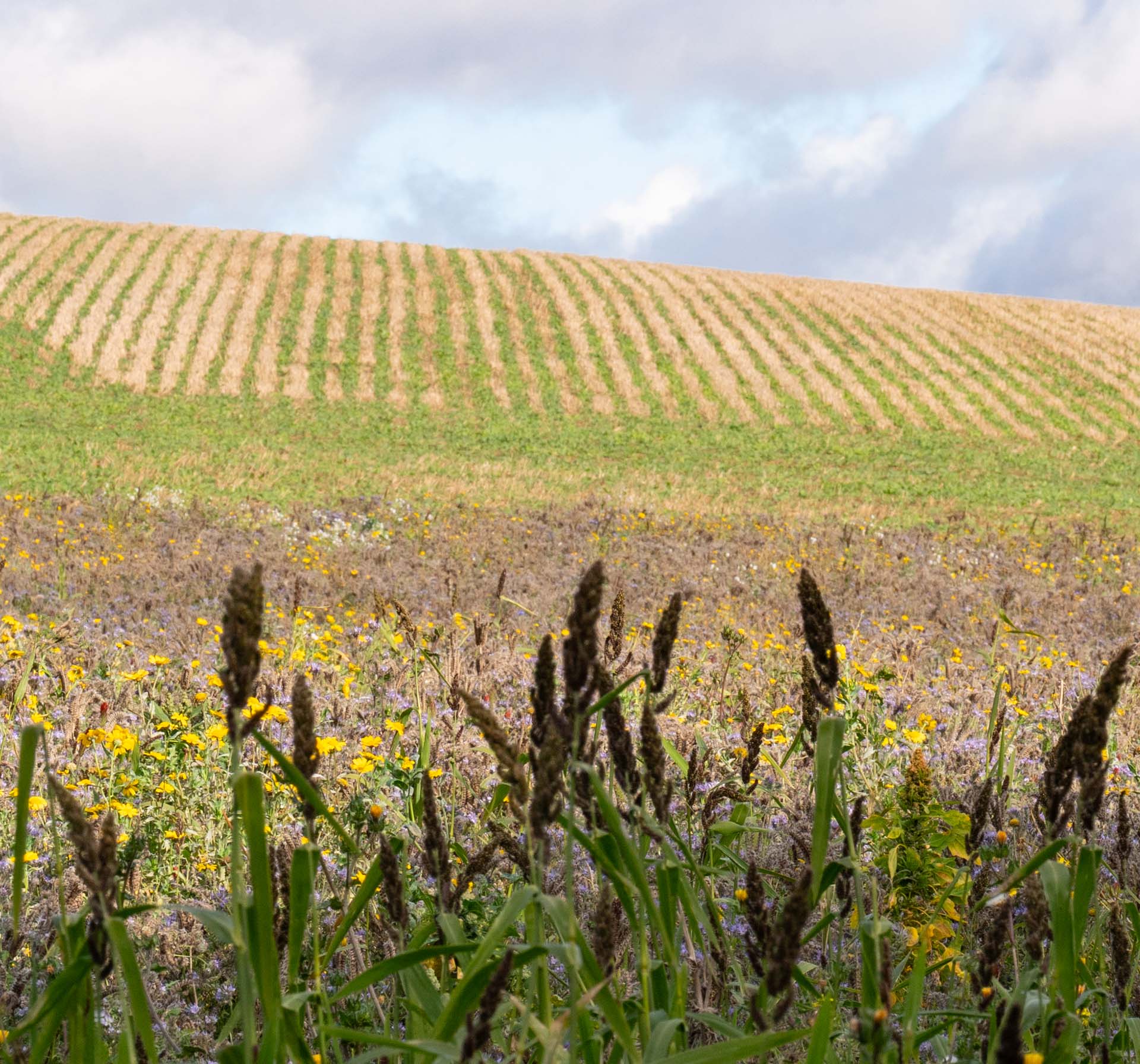

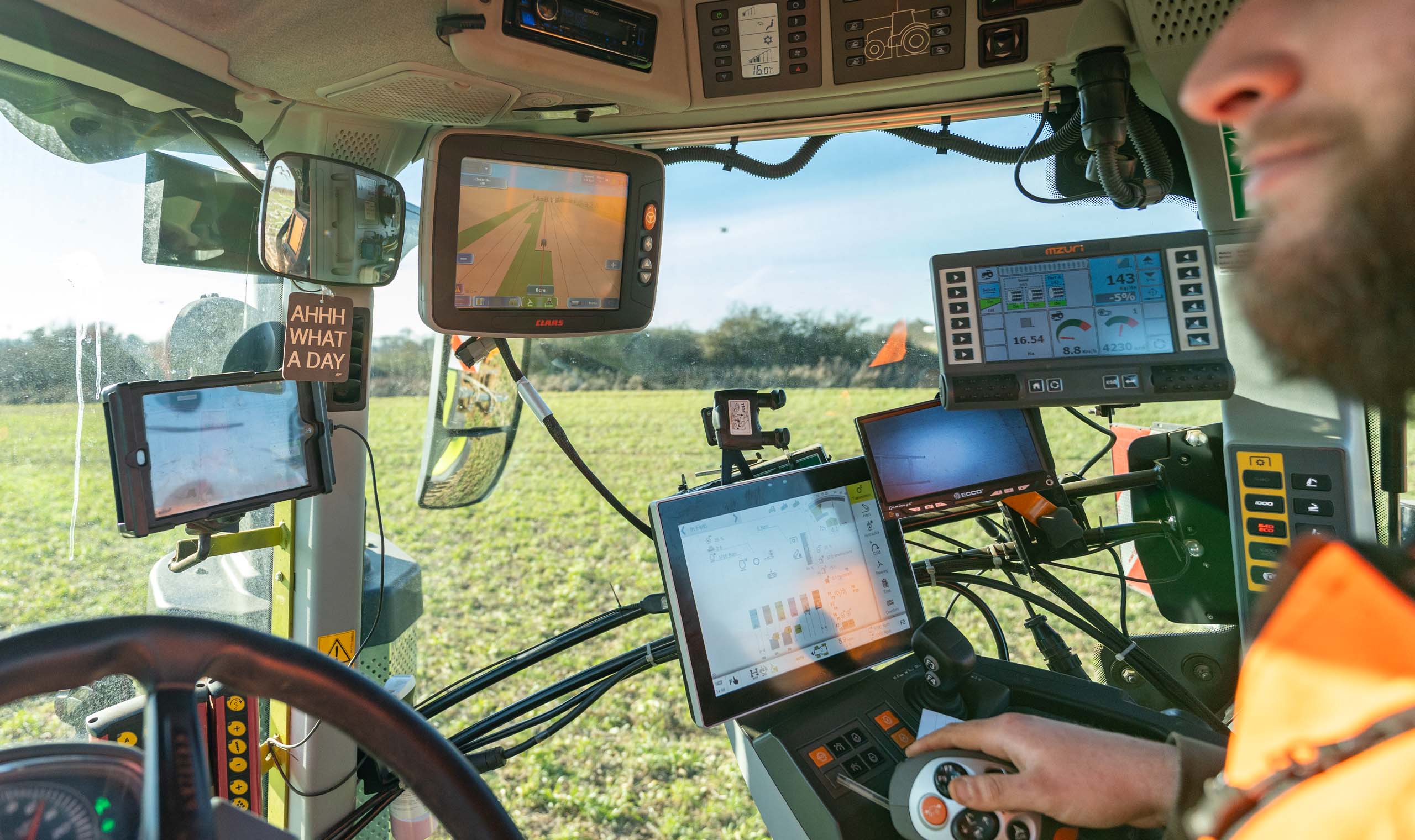
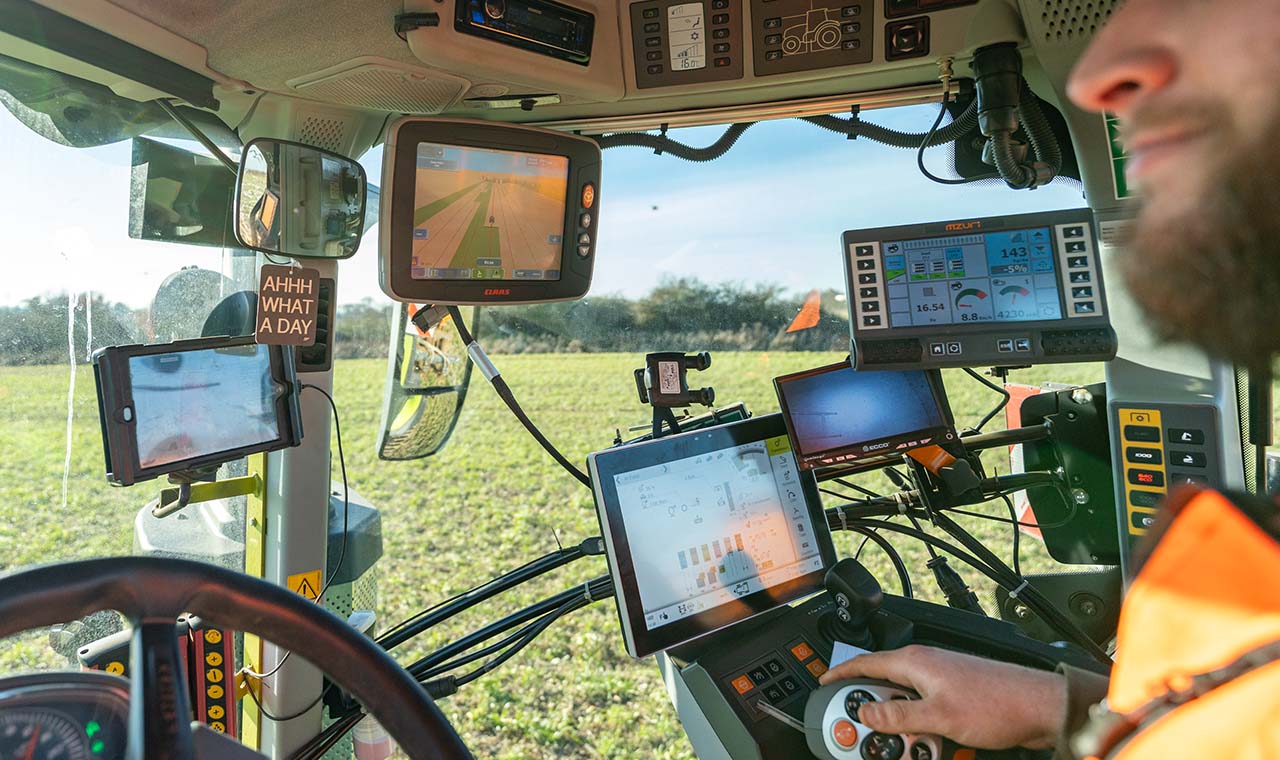
Operating Effectively Using Technology
Machinery is critical for getting the job done and requires a
consistent, sensible and safety driven approach to maximise output,
minimise downtime and ensure operator welfare, something that is
vital given the extended working hours through seasonal peaks. To
that end, the team all receive specific training for the operation and
maintenance of the equipment they are given responsibility.
Engineering advancements and computerisation have transformed
farming, to the point where many operations are semi-automatic,
with complete automation also beginning to appear in the industry.
Conant Farming has always embraced technology, when and where
it makes the business more productive. Most of the key machinery
is linked directly to office systems for transmitting work data, with
management also remotely monitoring performance and progress.
Getting the equipment & staffing right offers the ability to move
efficiently at the optimum time and reduces overall operating costs.
Crop Sprayer
A single machine like this can potentially achieve 200 hectares per day, allowing rapid progress
to meet critical timing requirements for nutrient or crop protection applications as soon as
conditions allow. Each sprayer is positionally aware and knows its speed of travel, automatically
adjusting flow rates and isolating nozzles to prevent excess application and overlap. Modern
sprayers are not only accurate but also better for the environment and less expensive to run.
With 36m boom widths, tramlines (wheeling’s) get spaced further apart to reduce costly
damage caused by soil compaction. Other field equipment can operate within factors of 36m
(typically 6 or 12m), giving a degree of controlled traffic farming (CTF). Of all the machines,
the sprayers make the most field visits, so are key pieces of equipment when it comes to CTF.
Combine Harvester
Efficiency is everything! One large combine can harvest approximately 1,500ha per season
with a driver and backup team. Compare that with an individual farm-sized machine (inc
driver/backup) which would typically achieve just a quarter of the output. Add in GPS
based yield mapping data, which (in addition to other testing/sampling activities) can
accurately program seed rates and nutrient requirements for the following season.
To further boost output and reduce losses, CFCO optimises each machine by utilising
12m (40ft) wide flex-draper headers. Engineered to float/follow ground contours to cut
all crops, including any that are laying flat, sending them into the combine feeder heads-
first ensuring threshing performance is truly maximised, whilst also leaving an evenly
trimmed stubble for simpler field workings that follow. These beds are also more user-
friendly and widen the operational window across early/late damper conditions.
An extended unloading auger on each combine allows the attending tractor/trailer (fitted
with floatation tyres) to travel along 12m tramlines, loosely in accordance with CTF.
Fixed Plant & Buildings
Not as exciting or striking as a flashy new piece of field equipment, and perhaps because of
that, investment in fixed plant and storage often goes unnoticed, but it can add significant
operational efficiencies. Grain dryers are a prime example (see the metal box with 3x outlets).
They allow activities to get ahead instead of waiting on the weather to dry crops until fit
for harvest, or worse, paying extortionate fees when delivering produce above contract
moisture levels directly to merchants. Having proper drying, cooling and storage facilities
avalable is like running a virtual combine, particularly in years with bad weather, which
unfortunately, seem to be becoming more frequent (certainly during harvest).
Each drying plant can normally keep pace with the output of a large combine, yet, with
competent management and extended working hours, can actually intake from two of them.
Additionally, it is worth noting that crops can be stored for extended periods of time (so long
as they remain sufficiently dry/cool). Having ample capacity can be useful if deciding to
defer sale when commodity prices look likely to increase (assuming cashflow allows).
Moving Forwards - Stronger Together
Historical data shows that since the end of World War II, UK farming
has on average achieved a threefold increase in wheat production, largely
resulting from advances in crop science and mechanical efficiencies.
However, despite the increased productivity levels, costs have also risen
markedly, whilst in real terms, wheat in 2025 is worth four times less
than in 1945. Farmers no longer receive a fair slice of the cake and haven’t
done so in a while. Food has become a global commodity with consumers
demanding more for less (with little regard for production standards/quality)
yet farmers face market volatility (for inputs & outputs) like never before.
As it stands, farms, and their supply chains, are finding it nigh on impossible
to survive. The root of the problem relates to irrational legislative decisions:
Post-Brexit abolition of subsidies, draconian regulation, imbalanced trading
agreements, and the uncertainty surrounding stewardship schemes; these are
all factors contributing to mounting industry-wide viability pressures.
Despite their best efforts, farmers across the country are being forced to
reconsider their generational livelihoods. Some decide to struggle on
because it’s what they do, supplementing their income by other means or
diversification. Others have already sold-out to corporate bodies, many of
whom primarily look at the land as an investment or tax offset rather than
for the value of food production or consideration for countryside care.
Have you ever considered contracting out your farm?
It may not be a solution for every business, but entering a contracting
arrangement can ease the pressure and offer a host of benefits, including:
Retaining ownership/trading status and receiving a fair income.
Freeing-up working capital through the sale of assets.
No day-to-day responsibilities and reduced administrative burden.
An increased depth of expertise, agronomy & operational ability.
Utilising machinery that is often more suitable, larger & efficient.
Equipped to work in a wider range of conditions.
Make savings through bulk procurement of inputs.
Lower risk by benefiting from group crop marketing power.
Receive extra income from farm assurance/compliance schemes.
Capability for drying and storing crops at lower rates.
With a proven track record for establishing and nurturing long-term client
relationships by creating tailor-made agreements that work for all stakeholders,
Conant Farming is interested in considering suitable expansion opportunities,
tackling the challenging times farming presently faces:
Please get in touch for an initial, confidential, and no obligation conversation.
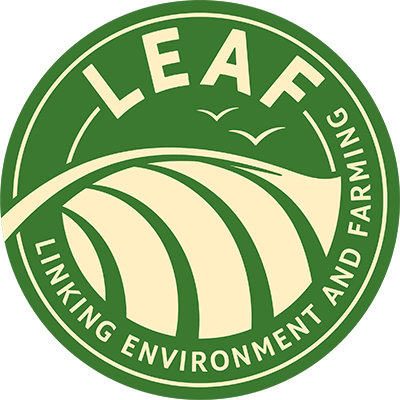
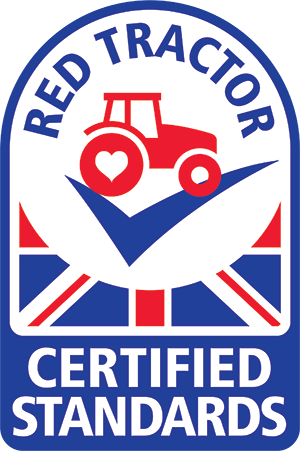
also encourages all farms to become LEAF members.

The Contract Farming Business - What We Do
Primarily, as a whole farm contracting business entrusted to manage extensive areas of
the countryside, Conant Farming recognises the responsibility for realising the potential
of all its land interests, and how operating sustainably protects the wider environment,
ultimately ensuring future generations remain able to produce crops.
Successful and profitable long-term partnerships are formed by appreciating the distinction
between different landowners and their respective settings, having a clear understanding
of any specific requirements and aspirations, and by always managing expectations.
CFCO formulates individually tailored contractor agreements from the outset. On the
ground, the team operates with universal attention to detail, getting the job done well.
Then, by holding regular landowner meetings, supporting open lines of communication,
consistently reporting against annual budgets and managing cashflows, customer
relationships build a natural mutual trust and resilience, enjoying success year-on-year.
CFCO farms for all landowners by…
Taking a sustainable approach.
Implementing regenerative farming.
Aiming for net zero.
Facilitating environmental income.
Operating effectively using technology.
Moving forwards, stronger together.
Crop Production - A Sustainable Approach
Conant Farming has lowered establishment costs by introducing
regenerative practices and implementing relevant environmental
stewardship schemes. This has maintained the profitable production
of some great crops across the contracted sites, whilst simultaneously
enhancing soil health and reducing the overall ecological impact.
In short, farming smarter with a longer-term view.
It’s not always about realising the greatest earnings in one perfect
season, only to suffer a wide variety of consequences in subsequent
years. The aim instead is to improve and support yields whilst
concurrently decreasing production costs - not just mechanically -
but by comprehensively working with, and not against nature.
The farming industry must evolve to survive, moving away from
intensive practices to provide for the next generation. CFCO is
already a leader in circularity, yet will always consider new
methodology aiming for improvements and efficiencies.
Regenerative Farming
A simple idea; recognising that everything
a plant needs should be readily available in the
soil. Ideally, growing crops shouldn’t require
cultivation, fertilisers or protection products.
By maintaining photosynthesising green cover
year-round, including companion cropping
where appropriate, not only is the soil surface
afforded protection, but all planting benefits
from the abundance of energy sequestered. It’s
also vital to understand that life below ground
is profiting from this continuous growth cycle,
almost beyond measure. Creating nutrient-rich
well-structured ‘living’ soils 'alive' with
microbiology often completely contrasts with
the relentless rigors of intensive farming.
Holistically achieving a more innate resilience
to crop disease, weed growth, and pest damage,
drastically reduces the need for synthetic
inputs. By further increasing organic matter
within the soil, the overall ground structure,
biodiversity and hydrological properties
improve. This not only promotes plant growth
but also provides resilience against adverse
weather conditions, and reduces or even
eliminates the need for heavy, costly and often
ecologically damaging 'reset' cultivations.
It takes time for the positive regenerative effects
to come to fruition, so Conant Farming aims to
strike a balance relative to the land conditions,
customer expectations and shorter-term viability.

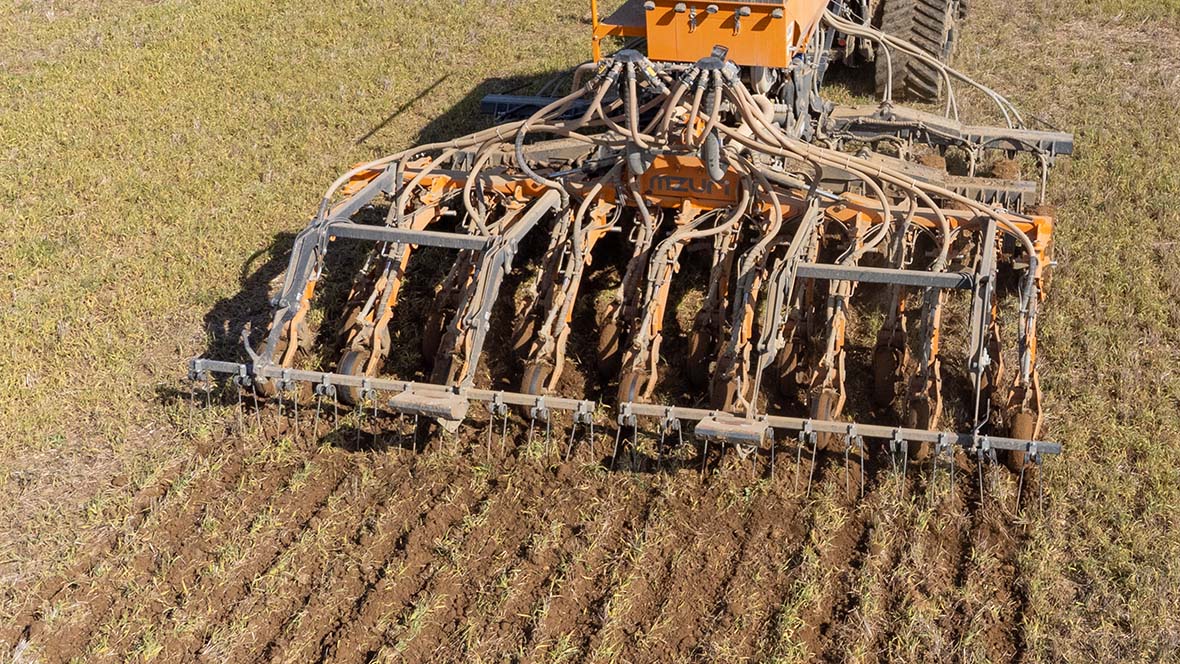
pics of strip-till drilling into heavy clay land,
taken on neighbouring plots at Lyndon. Post harvest,
one field remained as bare stubble whilst the other
had green cover planted immediately afterwards.
Aiming for Net Zero
With the clock ticking towards the point where the world must achieve net zero, many industries are now
looking to, or legally must, offset their greenhouse gas emissions where it is otherwise not possible to do
so. According to the NFU, the aim is for agriculture (in England & Wales) to meet this target by 2040.
Switching from an intensive cropping regime and implementing Conant Farming's already well-
established regenerative approaches, allows landowners to reduce their carbon footprint, improve soil
health, and increase the carbon sequester (storing more carbon in the soil than is emitted). Then,
adopting a measured carbon capture project may help build a more sustainable business model with
the landowner receiving tradeable credits for the carbon stored within their surplus capacity.
Some caution should be afforded given the relative infancy of carbon credit trading. Expert advice must
be sought, particularly as these schemes involve a long-term commitment where a predetermined ‘capture
period’ is followed by a further duration of ‘permanence’ to prevent carbon dioxide getting released back
into the atmosphere. It should also be noted that payments result from the additional carbon captured
(measured annually), amounts which will naturally subside in the approach to saturation - at this stage
nobody really knows how far organic matter increases can be driven. The scope for carbon storage also
varies from farm to farm, but many businesses globally are already taking advantage.
Whatever your view on decarbonisation, this is certainly something to consider.
CFCO is equipped and ready to help landowners achieve project targets.
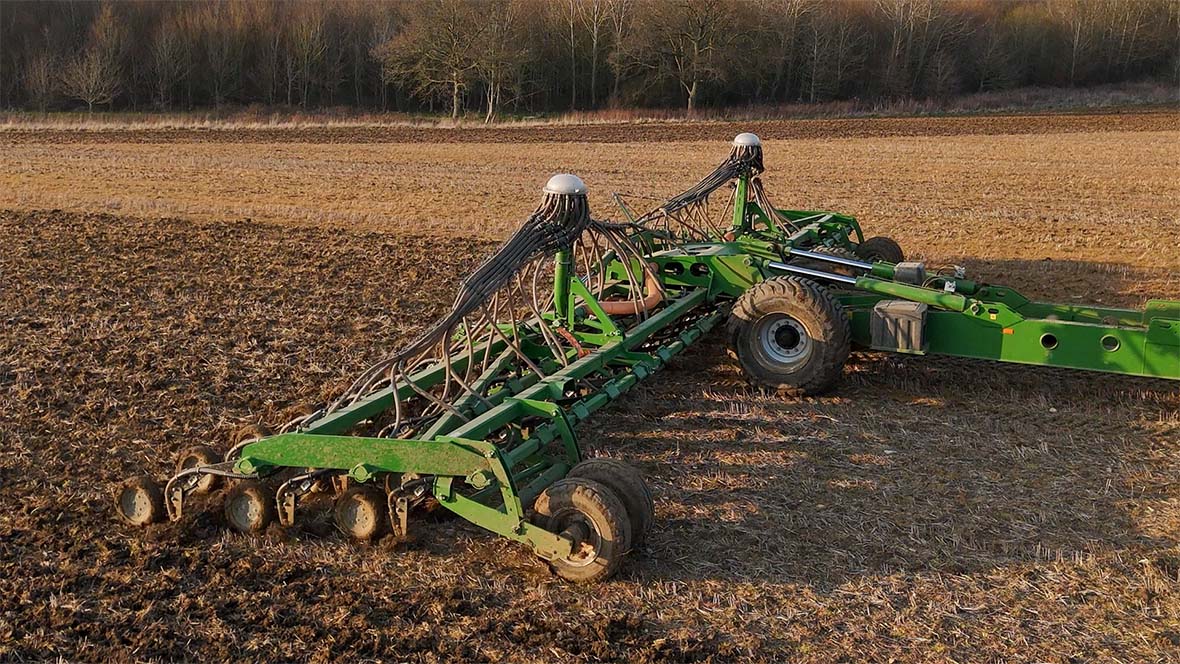
Facilitating Environmental Income
Post Brexit, the farming industry lost direct subsidies. Headlines like ‘public money for public good’
placed the spotlight on domestic food production. Despite all the publicity, and the magnificent work
that organisations such as LEAF (which CFCO is a member) do promoting and educating through their
labelling and running of events such as Open Farm Sunday, was it enough to justify further funding?
DEFRA's Environmental Land Management (ELM) schemes aim to offer additional income to underpin
domestic food security. Yet to appease the voters and steer policy, the support is effectively ‘sold’ to
landowners, provided in return for making enhancements to often already professionally managed, wildlife-
rich & diverse farmland. But it’s ironic that the earnings do not physically contribute to producing cash crops
or offer much to address the viability of farming! In fact, worryingly, a fair chunk of the population has a lack
of awareness when it comes to primary food production or that the UK is only about 60% self-sufficient.
However, by taking part in a variety of these diverse Government schemes since inception, many important
actions have been implemented; improving soil health, nutrient management, and pest control. Reducing
water pollution risk and regulating atmospheric emissions are other focal points of the ELM policies.
Conant Farming is well-placed to intelligently advise, design and effect any SFI (Sustainable Farming
Incentive) and CS (Countryside Stewardship) agreements, or any such future ‘safety net’ the Whitehall
Legislators formulate to 'mitigate' the financial disparities relating to the real-world cost of producing food.
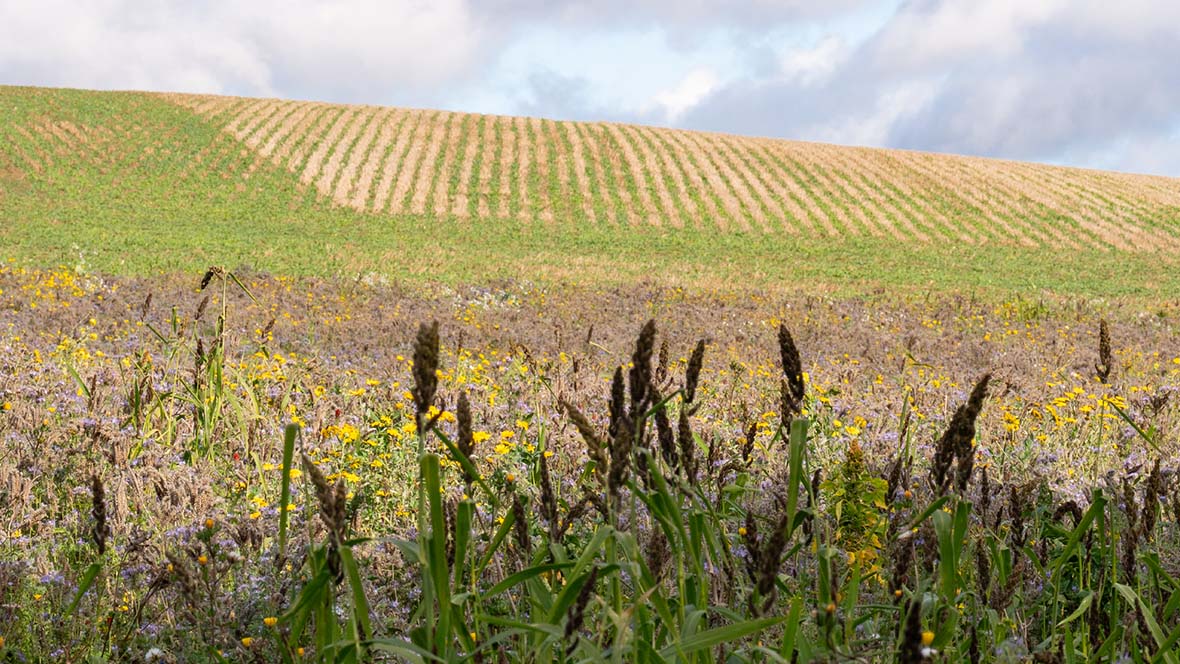
Operating Effectively Using Technology
Machinery is critical for getting the job done and requires a consistent, sensible and safety driven
approach to maximise output, minimise downtime and ensure operator welfare, something that is vital
given the extended working hours through seasonal peaks. To that end, the team all receive specific
training for the operation and maintenance of the equipment they are given responsibility.
Engineering advancements and computerisation have transformed farming, to the point where many
operations are semi-automatic, with complete automation also beginning to appear in the industry.
Conant Farming has always embraced technology, when and where it makes the business more
productive. Most of the key machinery is linked directly to office systems for transmitting work
data, with management also remotely monitoring performance and progress.
Getting the equipment & staffing right offers the ability to move efficiently at the optimum time
and reduces overall operating costs.
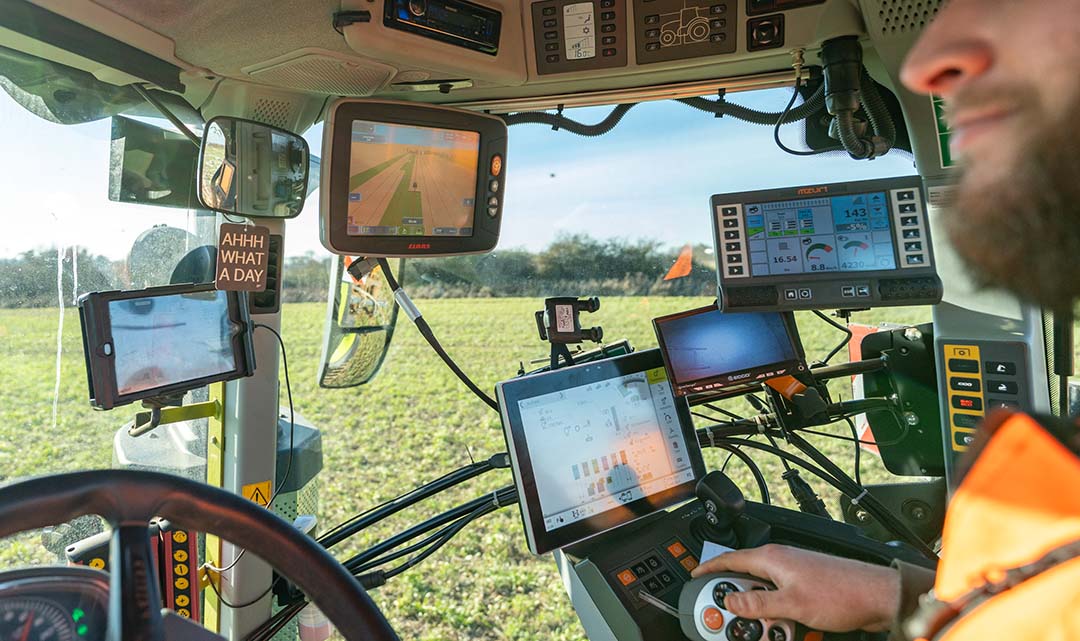
Crop Sprayer
A single machine like this can potentially achieve 200
hectares per day, allowing rapid progress to meet critical
timing requirements for nutrient or crop protection
applications as soon as conditions allow. Each sprayer is
positionally aware and knows its speed of travel,
automatically adjusting flow rates and isolating nozzles
to prevent excess application and overlap. Modern
sprayers are not only accurate but also better for the
environment and less expensive to run.
With 36m boom widths, tramlines (wheeling’s) get
spaced further apart to reduce costly damage caused by
soil compaction. Other field equipment can operate
within factors of 36m (typically 6 or 12m), giving a
degree of controlled traffic farming (CTF). Of all the
machines, the sprayers make the most field visits, so
are key pieces of equipment when it comes to CTF.
Combine Harvester
Efficiency is everything! One large combine can harvest
approximately 1,500ha per season with a driver and
backup team. Compare that with an individual farm-
sized machine (inc driver/backup) which would typically
achieve just a quarter of the output. Add in GPS based
yield mapping data, which (in addition to other
testing/sampling activities) can accurately program seed
rates and nutrient requirements for the following season.
To further boost output and reduce losses, a 12m (40ft)
wide flex-draper header is fitted to each machine.
Engineered to float/follow ground contours to cut all
crops, including any that are laying flat, sending them
into the combine feeder heads-first ensuring threshing
performance is truly maximised, whilst also leaving an
evenly trimmed stubble for simpler field workings that
follow. These beds are also more user-friendly and widen
the operational window across damper conditions.
An extended unloading auger allows the attending
tractor/trailer (fitted with floatation tyres) to travel along
12m tramlines, loosely in accordance with CTF.
Fixed Plant & Buildings
Not as exciting or striking as a flashy new piece of field
equipment, and perhaps because of that, investment in
fixed plant and storage often goes unnoticed, but it can
add significant operational efficiencies. Grain dryers are
a prime example (see the metal box with 3x outlets).
They allow activities to get ahead instead of waiting on
the weather to dry crops until fit for harvest, or worse,
paying extortionate fees when delivering produce above
contract moisture levels directly to merchants. Having
proper drying, cooling and storage facilities avalable is
like running a virtual combine, particularly in years with
bad weather, which unfortunately, seem to be becoming
more frequent (certainly during harvest).
Each drying plant can normally keep pace with the
output of a large combine, yet, with competent
management and extended working hours, can
actually intake from two of them.
Additionally, it is worth noting that crops can be stored
for extended periods of time (so long as they remain
sufficiently dry/cool). Having ample capacity can be
useful if deciding to defer sale when commodity prices
look likely to increase (assuming cashflow allows).
Moving Forwards - Stronger Together
Historical data shows that since the end of World War II, UK farming has on average achieved a threefold
increase in wheat production, largely resulting from advances in crop science and mechanical efficiencies.
However, despite increased productivity, costs have risen markedly, whilst in real terms, wheat in 2025 is
worth four times less than in 1945. Farmers no longer receive a fair slice of the cake and haven’t done so in a
while. Food has become a global commodity with consumers demanding more for less (with little regard for
production standards/quality) yet farmers face market volatility (for inputs & outputs) like never before.
As it stands, farms, and their supply chains, are finding it nigh on impossible to survive. The root of the
problem relates to irrational legislative decisions: Post-Brexit abolition of subsidies, draconian regulation,
imbalanced trading agreements, and the uncertainty surrounding stewardship schemes; these are all
factors contributing to mounting industry-wide viability pressures.
Despite their best efforts, farmers across the country are being forced to reconsider their generational
livelihoods. Some decide to struggle on, supplementing their income by other means or diversification.
Others have already sold-out to corporates, many of whom primarily look at the land as an investment
or tax offset rather than for the value of food production or consideration for countryside care.
Have you ever considered contracting out your farm?
It may not be a solution for every business, but entering a contracting
arrangement can ease the pressure and offer a host of benefits, including:
Retaining ownership/trading status and receiving a fair income.
Freeing-up working capital through the sale of assets.
No day-to-day responsibilities and reduced administrative burden.
An increased depth of expertise, agronomy & operational ability.
Utilising machinery that is often more suitable, larger & efficient.
Equipped to work in a wider range of conditions.
Make savings through bulk procurement of inputs.
Lower risk by benefiting from group crop marketing power.
Receive extra income from farm assurance/compliance schemes.
Capability for drying and storing crops at lower rates.
With a proven track record for establishing and nurturing long-term client
relationships by creating tailor-made agreements that work for all stakeholders,
Conant Farming is interested in considering suitable expansion opportunities,
tackling the challenging times farming presently faces:
Please get in touch for an initial, confidential, and no obligation conversation.
Tractor farm assurance and
also encourages all farms to
become LEAF members.

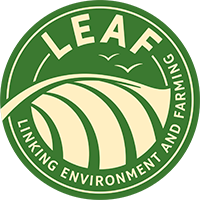
The Contract Farming Business - What We Do
Primarily, as a whole farm contracting business entrusted to manage
extensive areas of the countryside, Conant Farming recognises the
responsibility for realising the potential of all its land interests, and
how operating sustainably protects the wider environment,
ultimately ensuring future generations remain able to produce crops.
Successful and profitable long-term partnerships are formed by
appreciating the distinction between different landowners and their
respective settings, having a clear understanding of any specific
requirements and aspirations, and by always managing expectations.
CFCO formulates individually tailored contractor agreements from the
outset. On the ground, the team operates with universal attention to
detail, getting the job done well. Then, by holding regular landowner
meetings, supporting open lines of communication, consistently reporting
against annual budgets and managing cashflows, customer relationships
build a natural mutual trust and resilience, enjoying success year-on-year.
Taking a sustainable approach.
Implementing regenerative farming.
Aiming for net zero.
Facilitating environmental income.
Operating effectively using technology.
Moving forwards, stronger together.
Crop Production - A Sustainable Approach
Conant Farming has lowered establishment costs by introducing regenerative
practices and implementing relevant environmental stewardship schemes. This
has maintained the profitable production of some great crops across the
contracted sites, whilst simultaneously enhancing soil health and reducing the
overall ecological impact. In short, farming smarter with a longer-term view.
It’s not always about realising the greatest earnings in one perfect season, only to
suffer a wide variety of consequences in subsequent years. The aim instead is to
improve and support yields whilst concurrently decreasing production costs - not
just mechanically - but by comprehensively working with, and not against nature.
The farming industry must evolve to survive, moving away from intensive practices
to provide for the next generation. CFCO is already a leader in circularity, yet will
always consider new methodology aiming for improvements and efficiencies.
Regenerative Farming
A simple idea; recognising that everything a plant needs should be readily
available in the soil. Ideally, growing crops shouldn’t require cultivation,
fertilisers or protection products.
By maintaining photosynthesising green cover year-round, including companion
cropping where appropriate, not only is the soil surface afforded protection, but
all planting benefits from the abundance of energy sequestered. It’s also vital to
understand that life below ground is profiting from this continuous growth cycle,
almost beyond measure. Creating nutrient-rich well-structured ‘living’ soils 'alive'
with microbiology often completely contrasts with the rigors of intensive farming.
Holistically achieving a more innate resilience to crop disease, weed growth,
and pest damage, drastically reduces the need for synthetic inputs. By further
increasing organic matter within the soil, the ground structure, biodiversity and
hydrological properties improve. This not only promotes plant growth but also
provides resilience against adverse weather conditions, and reduces or even
eliminates the need for heavy, costly and often damaging 'reset' cultivations.
It takes time for the positive regenerative effects to come to fruition, so Conant
Farming aims to strike a balance relative to the land conditions, customer
expectations and shorter-term viability considerations.
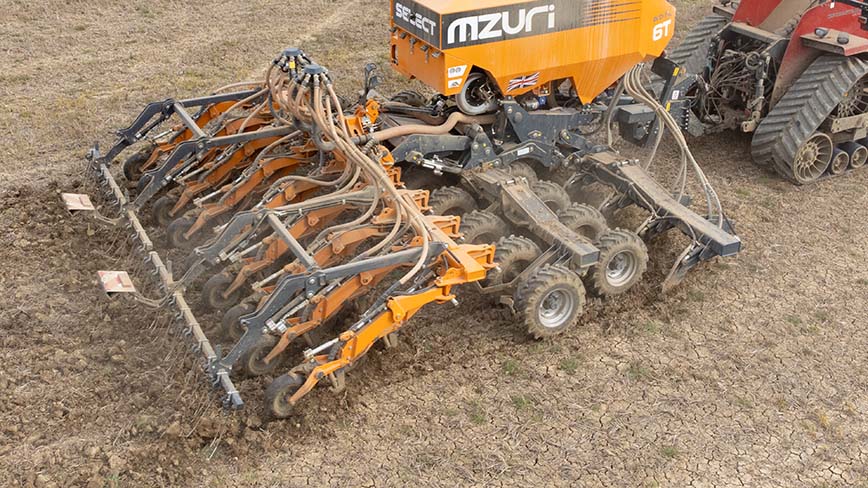
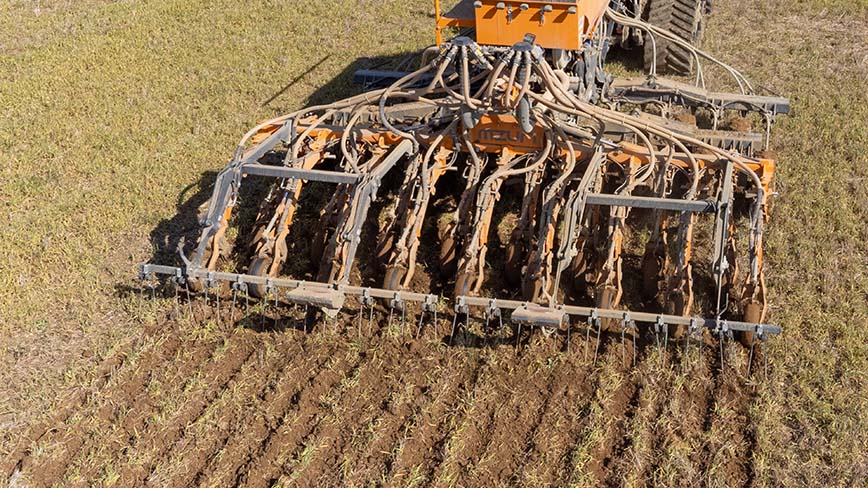
clay land, taken on neighbouring plots at Lyndon. Post harvest, one field remained as
bare stubble whilst the other had green cover planted immediately afterwards.
Aiming for Net Zero
With the clock ticking towards the point where the world must achieve net zero,
many industries are now looking to, or legally must, offset their greenhouse gas
emissions where it is otherwise not possible to do so. According to the NFU, the
aim is for agriculture (in England & Wales) to meet this target by 2040.
Switching from an intensive cropping regime and implementing Conant Farming's
already well-established regenerative approaches, allows landowners to reduce their
carbon footprint, improve soil health, and increase the carbon sequester (storing
more carbon in the soil than is emitted). Then, adopting a measured carbon capture
project may help build a more sustainable business model with the landowner
receiving tradeable credits for the carbon stored within their surplus capacity.
Caution should be afforded given the relative infancy of carbon credit trading.
Expert advice must be sought, particularly as these schemes involve a long-term
commitment where a predetermined ‘capture period’ is followed by a further
duration of ‘permanence’ to prevent carbon dioxide getting released back into the
atmosphere. It should also be noted that payments result from the additional
carbon captured (measured annually), amounts which will naturally subside in
the approach to saturation - at this stage nobody really knows how far organic
matter increases can be driven. The scope for carbon storage also varies from
farm to farm, but many businesses globally are already taking advantage.
Whatever your view on decarbonisation, this is certainly something to consider.
CFCO is equipped and ready to help landowners achieve project targets.
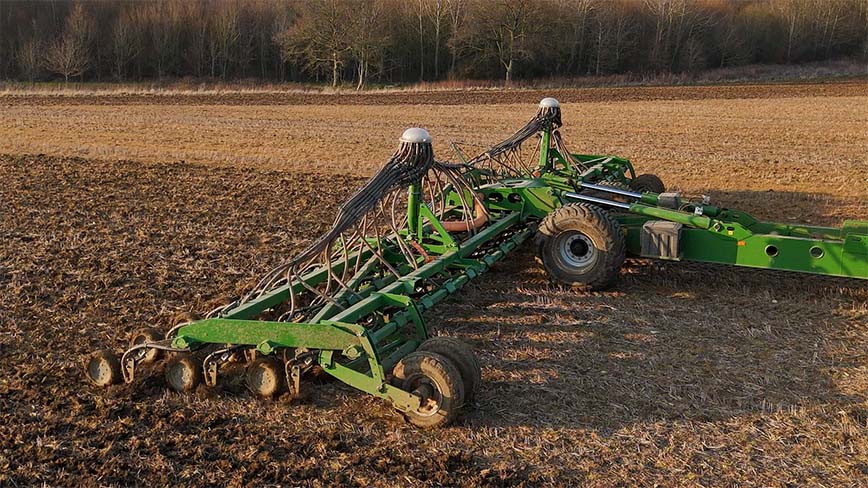
Facilitating Environmental Income
Post Brexit, the farming industry lost direct subsidies. Headlines like ‘public money
for public good’ placed the spotlight on domestic food production. Despite all the
publicity, and the magnificent work that organisations such as LEAF (which CFCO
is a member) do promoting and educating through their labelling and running of
events such as Open Farm Sunday, was it enough to justify further funding?
DEFRA's Environmental Land Management (ELM) schemes aim to offer
additional income to underpin domestic food security. Yet to appease the voters
and steer policy, the support is effectively ‘sold’ to landowners, provided in return
for making enhancements to often already professionally managed, wildlife-rich &
diverse farmland. But it’s ironic that the earnings do not physically contribute to
producing cash crops or offer much to address the viability of farming! In fact,
worryingly, a fair chunk of the population has a lack of awareness when it comes
to primary food production or that the UK is only about 60% self-sufficient.
However, by taking part in a variety of these diverse Government schemes since
inception, many important actions have been implemented; improving soil health,
nutrient management, and pest control. Reducing water pollution risk and
regulating atmospheric emissions are other focal points of the ELM policies.
Conant Farming is well-placed to intelligently advise, design and effect any SFI
(Sustainable Farming Incentive) and CS (Countryside Stewardship) agreements, or
any such future ‘safety net’ the Whitehall Legislators formulate to 'mitigate' the
financial disparities relating to the real-world cost of producing food.
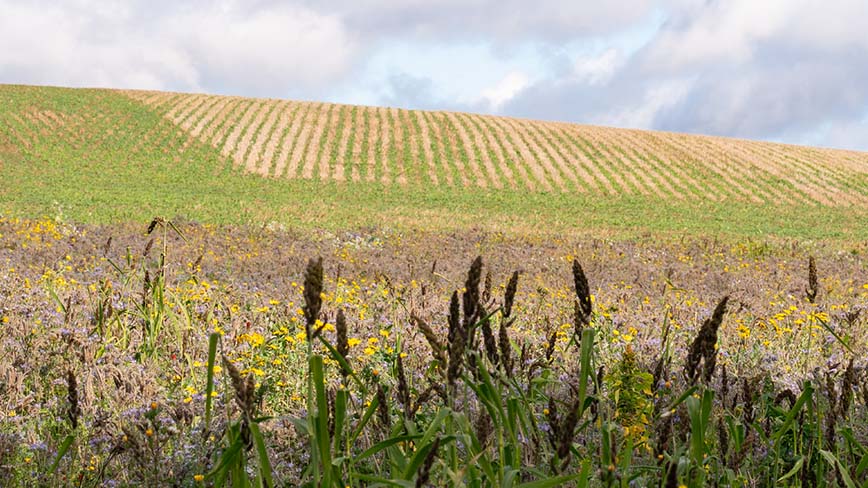
Operating Effectively Using Technology
Machinery is critical for getting the job done and requires a consistent,
sensible and safety driven approach to maximise output, minimise downtime
and ensure operator welfare, something that is vital given the extended working
hours through seasonal peaks. To that end, the team all receive specific
training for the operation and maintenance of the equipment they are using.
Engineering advancements and computerisation have transformed farming,
to the point where many operations are semi-automatic, with complete
automation also beginning to appear in the industry.
Conant Farming has always embraced technology, when and where it makes
the business more productive. Most of the key machinery is linked directly to
office systems for transmitting work data, with management also remotely
monitoring performance and progress.
Getting the equipment & staffing right offers the ability to move efficiently
at the optimum time and reduces overall operating costs.
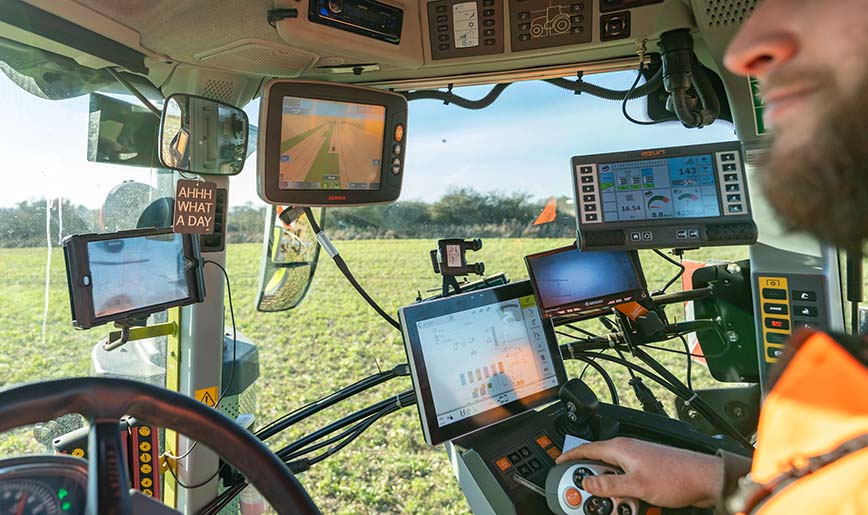
Crop Sprayer
A single machine like this can potentially
achieve 200 hectares per day, allowing rapid
progress to meet critical timing requirements
for nutrient or crop protection applications as
soon as conditions allow. Each sprayer is
positionally aware and knows its speed of
travel, automatically adjusting flow rates and
isolating nozzles to prevent excess application
and overlap. Modern sprayers are not only
accurate but also better for the environment
and less expensive to run.
With 36m boom widths, tramlines
(wheeling’s) get spaced further apart to reduce
costly damage caused by soil compaction.
Other field equipment can operate within
factors of 36m (typically 6 or 12m), giving a
degree of controlled traffic farming (CTF). Of
all the machines, the sprayers make the most
field visits, so are key pieces of equipment
when it comes to CTF.
Combine Harvester
Efficiency is everything! One large combine can
harvest approximately 1,500ha per season with
a driver and backup team. Compare that with
an individual farm-sized machine (inc
driver/backup) which would typically achieve
just a quarter of the output. Add in GPS based
yield mapping data, which (in addition to
other testing/sampling activities) can accurately
program seed rates and nutrient requirements
for the following season.
To further boost output and reduce losses, a
12m (40ft) wide flex-draper header is fitted to
each machine. Engineered to float/follow
ground contours to cut all crops, including
any that are laying flat, sending them into the
combine feeder heads-first ensuring threshing
performance is truly maximised, whilst also
leaving an evenly trimmed stubble for simpler
field workings that follow. These beds are also
more user-friendly and widen the operational
window across early/late damper conditions.
An extended unloading auger allows the
attending tractor/trailer (fitted with floatation
tyres) to travel along 12m CTF tramlines.
Fixed Plant & Buildings
Not as exciting or striking as a flashy new piece
of field equipment, and perhaps because of
that, investment in fixed plant and storage
often goes unnoticed, but it can add significant
operational efficiencies. Grain dryers are a
prime example (see the box with 3x outlets).
They allow activities to get ahead instead of
waiting on the weather to dry crops until fit for
harvest, or worse, paying extortionate fees
when delivering produce above contract
moisture levels directly to merchants. Having
proper drying, cooling and storage facilities
avalable is like running a virtual combine,
particularly in years with bad weather, which
unfortunately, seem to be becoming more
frequent (certainly during harvest).
Each drying plant can normally keep pace
with the output of a large combine, yet, with
competent management and extended working
hours, can actually intake from two of them.
Additionally, it is worth noting that crops can
be stored for extended periods of time (so long
as they remain sufficiently dry/cool). Having
ample capacity can be useful if deciding to
defer sale when commodity prices look likely
to increase (assuming cashflow allows).
Moving Forwards - Stronger Together
Historical data shows that since the end of World War II, UK farming
has on average achieved a threefold increase in wheat production, largely
resulting from advances in crop science and mechanical efficiencies.
However, despite the increased productivity levels, costs have also risen
markedly, whilst in real terms, wheat in 2025 is worth four times less than in
1945. Farmers no longer receive a fair slice of the cake and haven’t done so in
a while. Food has become a global commodity with consumers demanding
more for less (with little regard for production standards/quality) yet farmers
face market volatility (for inputs & outputs) like never before.
As it stands, farms, and their supply chains, are finding it nigh on impossible
to survive. The root of the problem relates to irrational legislative decisions:
Post-Brexit abolition of subsidies, draconian regulation, imbalanced trading
agreements, and the uncertainty surrounding stewardship schemes; these are
all factors contributing to mounting industry-wide viability pressures.
Despite their best efforts, farmers across the country are being forced to
reconsider their generational livelihoods. Some decide to struggle on
because it’s what they do, supplementing their income by other means or
diversification. Others have already sold-out to corporate bodies, many of
whom primarily look at the land as an investment or tax offset rather than
for the value of food production or consideration for countryside care.
Have you ever considered contracting out your farm?
It may not be a solution for every business, but entering a contracting
arrangement can ease the pressure and offer a host of benefits, including:
Retaining ownership/trading status and receiving a fair income.
Freeing-up working capital through the sale of assets.
No day-to-day responsibilities and reduced administrative burden.
An increased depth of expertise, agronomy & operational ability.
Utilising machinery that is often more suitable, larger & efficient.
Equipped to work in a wider range of conditions.
Make savings through bulk procurement of inputs.
Lower risk by benefiting from group crop marketing power.
Receive extra income from farm assurance/compliance schemes.
Capability for drying and storing crops at lower rates.
With a proven track record for establishing and nurturing long-term client
relationships by creating tailor-made agreements that work for all stakeholders,
Conant Farming is interested in considering suitable expansion opportunities,
tackling the challenging times farming presently faces:
Please get in touch for an initial, confidential, and no obligation conversation.


The Contract Farming Business - What We Do
Primarily, as a whole farm contracting business entrusted
to manage extensive areas of the countryside, Conant
Farming recognises the responsibility for realising the
potential of all its land interests, and how operating
sustainably protects the wider environment, ultimately
ensuring future generations remain able to produce crops.
Successful and profitable long-term partnerships are
formed by appreciating the distinction between different
landowners and their respective settings, having a clear
understanding of any specific requirements and
aspirations, and by always managing expectations.
CFCO formulates individually tailored contractor
agreements from the outset. On the ground, the team
operates with universal attention to detail, getting the job
done well. Then, by holding regular landowner meetings,
supporting open lines of communication, consistently
reporting against annual budgets and managing cashflows,
customer relationships build a natural mutual trust and
resilience, enjoying success year-on-year.
Taking a sustainable approach.
Implementing regenerative farming.
Aiming for net zero.
Facilitating environmental income.
Operating effectively using technology.
Moving forwards, stronger together.
Crop Production - A Sustainable Approach
Conant Farming has lowered establishment costs by
introducing regenerative practices and implementing
relevant environmental stewardship schemes. This has
maintained the profitable production of some great crops
across the contracted sites, whilst simultaneously enhancing
soil health and reducing the overall ecological impact.
In short, farming smarter with a longer-term view.
It’s not always about realising the greatest earnings in
one perfect season, only to suffer a wide variety of
consequences in subsequent years. The aim instead is to
improve and support yields whilst concurrently decreasing
production costs - not just mechanically - but by
comprehensively working with, and not against nature.
The farming industry must evolve to survive, moving away
from intensive practices to provide for the next generation.
CFCO, already a leader in circularity, will always consider
new methodology aiming for improvements and efficiencies.
Regenerative Farming
A simple idea; recognising that everything a plant needs
should be readily available in the soil. Ideally, growing crops
shouldn’t require cultivation, fertilisers or protection products.
By maintaining photosynthesising green cover year-round,
including companion cropping where appropriate, not only is
the soil surface afforded protection, but all planting benefits
from the abundance of energy sequestered. It’s also vital to
understand that life below ground is profiting from this
continuous growth cycle, almost beyond measure. Creating
nutrient-rich well-structured ‘living’ soils 'alive' with
microbiology often completely contrasts with the relentless
rigors of intensive farming.
Holistically achieving a more innate resilience to crop disease,
weed growth, and pest damage, drastically reduces the need
for synthetic inputs. By further increasing organic matter
within the soil, the overall ground structure, biodiversity and
hydrological properties improve. This not only promotes plant
growth but also provides resilience against adverse weather
conditions, and reduces or even eliminates the need for heavy,
costly and often ecologically damaging 'reset' cultivations.
It takes time for the positive regenerative effects to come to
fruition, so CFCO aims to strike a balance relative to the land
conditions, customer expectations and shorter-term viability.
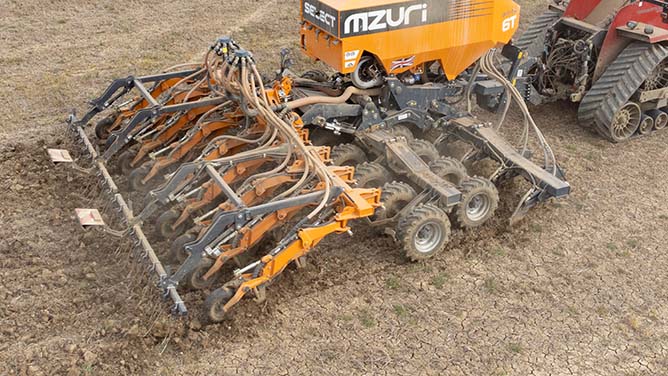
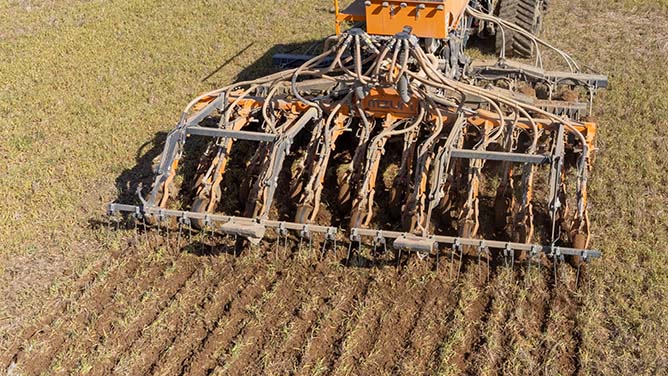
drilling into heavy clay land, taken on neighbouring plots at
Lyndon. Post harvest, one field remained as bare stubble whilst
the other had green cover planted immediately afterwards.
Aiming for Net Zero
With the clock ticking towards the point where the
world must achieve net zero, many industries are now looking
to, or legally must, offset greenhouse gas emissions where it is
otherwise not possible to do so. The NFU says the aim is for
agriculture (in England & Wales) to meet this target by 2040.
Switching across from an intensive cropping regime and
implementing Conant's already well-established regenerative
approaches, allows landowners to reduce their carbon
footprint, improve soil health, and increase the carbon
sequester (storing more in the soil than emitted). Then,
adopting a measured carbon capture project may help build a
more sustainable business model with the landowner receiving
tradeable credits for the carbon stored within their surplus.
Caution should be afforded given the relative infancy of
carbon credit trading. Expert advice must be sought,
particularly as schemes involve a long-term commitment
where a predetermined ‘capture period’ is followed by a
further duration of ‘permanence’ to prevent carbon dioxide
getting released back into the atmosphere. It should also be
noted that payments result from the additional carbon
captured (measured annually), amounts which will naturally
subside in the approach to saturation - at this stage nobody
really knows how far organic matter increases can be driven.
The scope for carbon storage also varies from farm to farm,
but many businesses globally are already taking advantage.
Whatever your view on decarbonisation, this is certainly
something to consider. Conant Farming is equipped and
ready to help landowners achieve project targets.
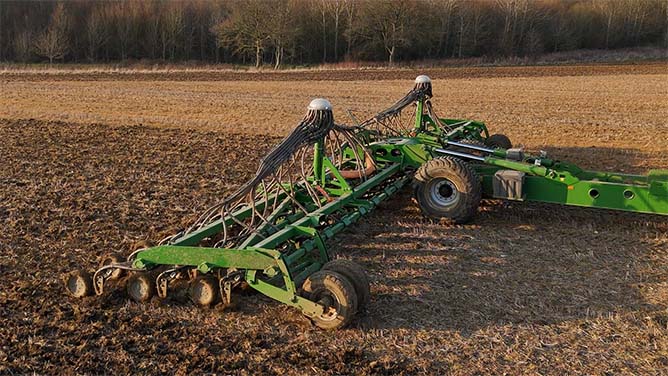
Facilitating Environmental Income
Post Brexit, the farming industry lost direct subsidies.
Headlines like ‘public money for public good’ placed the
spotlight on domestic food production. Despite all the
publicity, and the magnificent work that organisations such as
LEAF (CFCO is a member) do promoting and educating
through their labelling and running of events such as Open
Farm Sunday, was it enough to justify further funding?
DEFRA's Environmental Land Management (ELM) schemes
aim to offer additional income to underpin domestic food
security. Yet to appease the voters and steer policy, the
support is effectively ‘sold’ to landowners, provided in return
for making enhancements to often already professionally
managed, wildlife-rich & diverse farmland. But it’s ironic
that the earnings do not physically contribute to producing
cash crops or offer much to address the viability of farming!
In fact, worryingly, a fair chunk of the population has a lack
of awareness when it comes to primary food production or
that the UK is only about 60% self-sufficient.
However, by taking part in a variety of these diverse schemes
since inception, many important actions have been
implemented; improving soil health, nutrient management,
and pest control. Reducing water pollution risk and
regulating emissions are other focal points of the policies.
CFCO is well-placed to intelligently advise, design and effect
any SFI (Sustainable Farming Incentive) and CS (Countryside
Stewardship) agreements, or any such future ‘safety net’ the
Whitehall Legislators formulate to 'mitigate' the financial
disparities relating to the real-world cost of producing food.
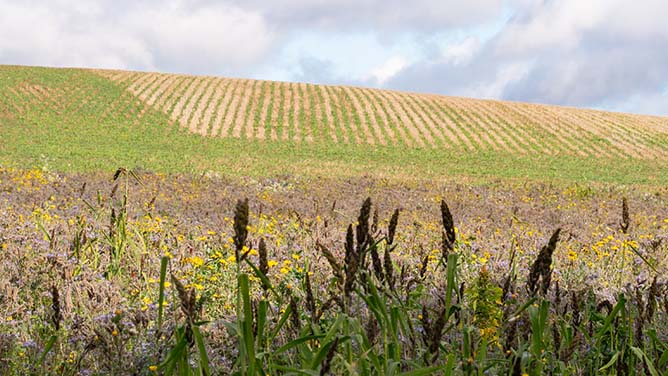
Operating Effectively Using Technology
Machinery is critical for getting the job done and requires a
consistent, sensible and safety driven approach to maximise
output, minimise downtime and ensure operator welfare;
vital given the extended working hours through seasonal peaks.
To that end, the team all receive specific training for the
operation and maintenance of the equipment they are using.
Engineering advancements and computerisation have
transformed farming, to the point where many operations
are semi-automatic, with complete automation also
beginning to appear in the industry.
Conant Farming has always embraced technology, when and
where it makes the business more productive. Most of the key
machinery is linked directly to office systems for transmitting
work data, with management also able to remotely monitor
performance and progress.
Getting the equipment & staffing right offers the ability to
move efficiently at the optimum time and reduces costs.
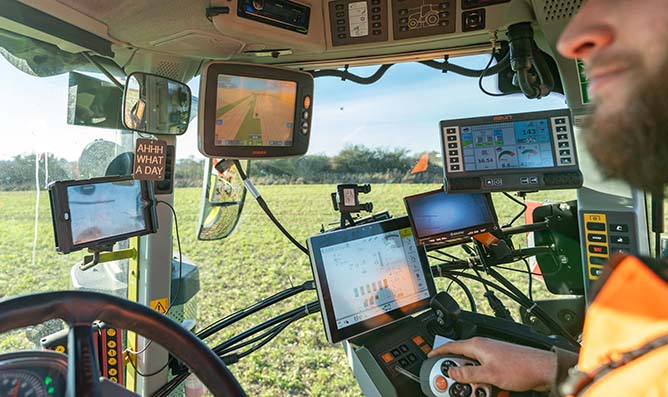
Crop
Sprayer
A single machine like this can potentially achieve 200
hectares per day, allowing rapid progress to meet critical
timing requirements for nutrient or crop protection
applications as soon as conditions allow. Each sprayer is
positionally aware and knows its speed of travel,
automatically adjusting flow rates and isolating nozzles
to prevent excess application and overlap. Modern
sprayers are not only accurate but also better for the
environment and less expensive to run.
With 36m boom widths, tramlines (wheeling’s) get
spaced further apart to reduce costly damage caused by
soil compaction. Other field equipment can operate
within factors of 36m (typically 6 or 12m), giving a
degree of controlled traffic farming (CTF). Of all the
machines, the sprayers make the most field visits, so are
key pieces of equipment when it comes to CTF.
Combine
Harvester
Efficiency is everything! One large combine can harvest
approximately 1,500ha per season with a driver and
backup team. Compare that with an individual farm-sized
machine (inc driver/backup) which would typically
achieve just a quarter of the output. Add in GPS based
yield mapping data, which (in addition to other
testing/sampling activities) can accurately program seed
rates and nutrient requirements for the following season.
To further boost output and reduce losses, a 12m (40ft)
wide flex-draper header is fitted to each machine.
Engineered to float/follow ground contours to cut all
crops, including any that are laying flat, sending them
into the combine feeder heads-first ensuring threshing
performance is truly maximised, whilst also leaving an
evenly trimmed stubble for simpler field workings that
follow. These beds are also more user-friendly and widen
the operational window across damper conditions.
An extended unloading auger allows the attending
tractor/trailer (fitted with floatation tyres) to travel
along the 12m CTF tramlines.
Fixed Plant
& Buildings
Not as exciting or striking as a flashy new piece of field
equipment, and perhaps because of that, investment in
fixed plant and storage often goes unnoticed, but it can
add significant operational efficiencies. Grain dryers are
a prime example (see the metal box with 3x outlets).
They allow activities to get ahead instead of waiting on
the weather to dry crops until fit for harvest, or worse,
paying extortionate fees when delivering produce above
contract moisture levels directly to merchants. Having
proper drying, cooling and storage facilities avalable is
like running a virtual combine, particularly in years
with bad weather, which unfortunately, seem to be
becoming more frequent (certainly during harvest).
Each drying plant can normally keep pace with the
output of a large combine, yet, with competent
management and extended working hours, can
actually intake from two of them.
Additionally, it is worth noting that crops can be stored
for extended periods of time (so long as they remain
sufficiently dry/cool). Having ample capacity can be
useful if deciding to defer sale when commodity prices
look likely to increase (assuming cashflow allows).
Moving Forwards - Stronger Together
Historical data shows that since the end of
World War II, UK farming has on average achieved a
threefold increase in wheat production, largely resulting
from advances in crop science and mechanical efficiencies.
However, despite the increased productivity levels, costs
have also risen markedly, whilst in real terms, wheat in
2025 is worth four times less than in 1945. Farmers no
longer receive a fair slice of the cake and haven’t done so
in a while. Food has become a global commodity with
consumers demanding more for less (with little regard for
production standards/quality) yet farmers face market
volatility (for inputs & outputs) like never before.
As it stands, farms, and their supply chains, are finding it
nigh on impossible to survive. The root of the problem
relates to irrational legislative decisions: Post-Brexit
abolition of subsidies, draconian regulation, imbalanced
trading agreements, and the uncertainty surrounding
stewardship schemes; these are all factors contributing
to mounting industry-wide viability pressures.
Despite their best efforts, farmers across the country are
being forced to reconsider their generational livelihoods.
Some decide to struggle on because it’s what they do,
supplementing their income by other means or
diversification. Others have already sold-out to corporate
bodies, many of whom primarily look at the land as an
investment or tax offset rather than for the value of food
production or consideration for countryside care.
Have you ever considered contracting out your farm?
It may not be a solution for every business, but entering
a contracting arrangement can ease the pressure and
offer a host of benefits, including:
- Retaining ownership/trading status and
receiving a fair income. - Freeing-up working capital through the
sale of assets. - No day-to-day responsibilities and
reduced administrative burden. - An increased depth of expertise,
agronomy & operational ability. - Utilising machinery that is often more
suitable, larger & efficient. - Equipped to work in a wider range of
conditions. - Make savings through bulk procurement
of inputs. - Lower risk by benefiting from group crop
marketing power. - Receive extra income from farm
assurance/compliance schemes. - Capability for drying and storing crops at
lower rates.
With a proven track record for establishing and
nurturing long-term client relationships by creating
tailor-made agreements that work for all stakeholders,
Conant Farming is interested in considering suitable
expansion opportunities, tackling the challenging times
farming presently faces:
Please get in touch for an initial,
confidential, and no obligation conversation.
also encourages all farms to become LEAF members.
The Contract Farming Business - What We Do
Primarily, as a whole farm contracting
business entrusted to manage extensive
areas of the countryside, Conant Farming
recognises the responsibility for realising the
potential of all its land interests, and how
operating sustainably protects the wider
environment, ultimately ensuring future
generations remain able to produce crops.
Successful and profitable long-term
partnerships are formed by appreciating the
distinction between different landowners
and their respective settings, having a clear
understanding of specific requirements and
aspirations, and by managing expectations.
CFCO formulates individually tailored
contractor agreements from the outset. On
the ground, the team operates with universal
attention to detail, getting the job done well.
Then, by holding regular meetings,
supporting open lines of communication,
consistently reporting against budgets and
managing cashflows, customer relationships
build a natural mutual trust and resilience,
enjoying success year-on-year.
Taking a sustainable approach.
Implementing regenerative farming.
Aiming for net zero.
Facilitating environmental income.
Operating effectively using technology.
Moving forwards, stronger together.
Crop Production
A Sustainable Approach
Conant Farming has lowered establishment
costs by introducing regenerative practices
and implementing relevant environmental
stewardship schemes. This has maintained
the profitable production of some great
crops across the contracted sites, whilst
simultaneously enhancing soil health and
reducing the overall ecological impact.
Farming smarter with a longer-term view.
It’s not always about realising the greatest
earnings in the one perfect season, only to
suffer a wide variety of consequences in
subsequent years. The aim instead is to
improve and support yields whilst
concurrently decreasing production
costs - not just mechanically - but by
comprehensively working with, and not
against nature.
The farming industry must evolve to survive,
moving away from intensive practices to
provide for the next generation. CFCO,
already a leader in circularity, will always
consider new methodology aiming for
improvements and efficiencies.
Regenerative Farming
A simple idea; recognising that everything a
plant needs should be readily available in the
soil. Ideally, growing crops shouldn’t require
cultivation, fertilisers or protection products.
By maintaining photosynthesising green
cover year-round, including companion
cropping where appropriate, not only is the
soil surface afforded protection, but all
planting benefits from the abundance of
energy sequestered. It’s also vital to
understand that life below ground is
profiting from this continuous growth cycle,
almost beyond measure. Creating nutrient-
rich well-structured ‘living’ soils 'alive' with
microbiology often completely contrasts
with the rigors of intensive farming.
Holistically achieving a more innate
resilience to crop disease, weed growth, and
pest damage, drastically reduces the need for
synthetic inputs. By further increasing
organic matter within the soil, the overall
ground structure, biodiversity and
hydrological properties improve. This not
only promotes plant growth but also
provides resilience against adverse weather
conditions, and reduces or even eliminates
the need for heavy, costly and often
ecologically damaging 'reset' cultivations.
It takes time for the positive regenerative
effects to come to fruition, so CFCO aims
to strike a balance relative to the land
conditions, customer expectations and
shorter-term viability considerations.

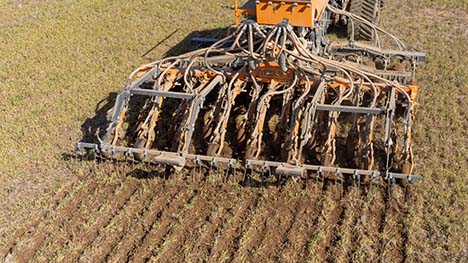
these pics of strip-till drilling into heavy
clay land, taken on neighbouring plots.
Post harvest, one field remained as bare
stubble whilst the other had green cover
planted immediately afterwards.
Aiming for Net Zero
With the clock ticking towards the point
where the world must achieve net zero,
many industries are now looking to, or
legally must, offset greenhouse gas emissions
where it is otherwise not possible to do so.
The NFU says the aim is for agriculture (in
Eng & Wales) to meet this target by 2040.
Switching across from an intensive cropping
regime and implementing Conant's already
well-established regenerative approaches,
allows landowners to reduce their carbon
footprint, improve soil health, and increase
the carbon sequester (storing more in the soil
than emitted). Then, adopting a measured
carbon capture project may help build a
more sustainable business model with the
landowner receiving tradeable credits for the
carbon stored within their surplus.
Some caution should be afforded given the
relative infancy of carbon credit trading.
Expert advice must be sought, particularly as
schemes involve a long-term commitment
where a predetermined ‘capture period’ is
followed by a further duration of
‘permanence’ to prevent carbon dioxide
getting released back into the atmosphere. It
should also be noted that payments result
from the additional carbon captured
(measured annually), amounts which will
naturally subside in the approach to
saturation - at this stage nobody really knows
how far organic matter increases can be
driven. The scope for carbon storage also
varies from farm to farm, but many
businesses globally are taking advantage.
Whatever your view on decarbonisation, this
is certainly something to consider. Conant
Farming is equipped and ready to help
landowners achieve project targets.
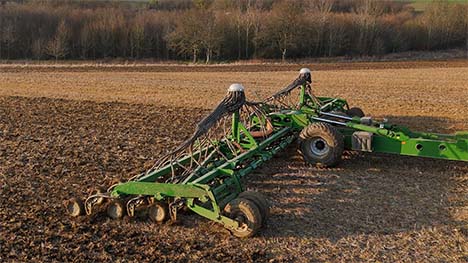
Facilitating
Environmental Income
Post Brexit, the farming industry lost
direct subsidies. Headlines like ‘public
money for public good’ placed the
spotlight on domestic food production.
Despite all the publicity, and the
magnificent work that organisations such
as LEAF (CFCO is a member) do
promoting and educating through their
labelling and running of events such as
Open Farm Sunday, was it enough to
justify further funding?
DEFRA's Environmental Land
Management (ELM) schemes aim to offer
additional income to underpin domestic
food security. Yet to appease the voters and
steer policy, the support is effectively ‘sold’
to landowners, provided in return for
making enhancements to often already
professionally managed, wildlife-rich &
diverse farmland. But it’s ironic that the
earnings do not physically contribute to
producing cash crops or offer much to
address the viability of farming! In fact,
worryingly, a fair chunk of the population
has a lack of awareness when it comes to
primary food production or that the UK
is only about 60% self-sufficient.
However, by taking part in a variety of
these diverse schemes since inception,
many important actions have been
implemented; improving soil health,
nutrient management, and pest control.
Reducing water pollution risk and
regulating emissions are other focal
points of the policies.
CFCO is well-placed to intelligently
advise, design and effect any SFI
(Sustainable Farming Incentive) and CS
(Countryside Stewardship) agreements, or
any such future ‘safety net’ the Whitehall
Legislators formulate to 'mitigate' the
financial disparities relating to the real-
world cost of producing food.
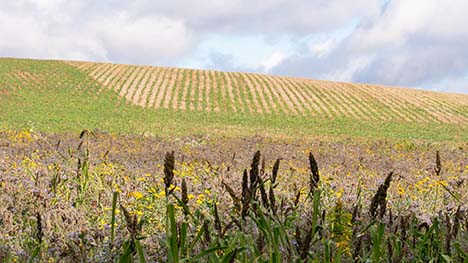
Operating Effectively
Using Technology
Machinery is critical for getting the job
done and requires a consistent, sensible and
safety driven approach to maximise output,
minimise downtime and ensure operator
welfare; vital given the extended working
hours through seasonal peaks. To that
end, the team all receive specific training
for the operation and maintenance of
the equipment they are using.
Engineering advancements and
computerisation have transformed farming,
to the point where many operations are
semi-automatic, with complete automation
also beginning to appear in the industry.
Conant Farming has always embraced
technology, when and where it makes the
business more productive. Most of the key
machinery is linked directly to office
systems for transmitting work data, with
management also able to remotely monitor performance and progress.
Getting the equipment & staffing right
offers the ability to move efficiently at the
optimum time and reduces costs.
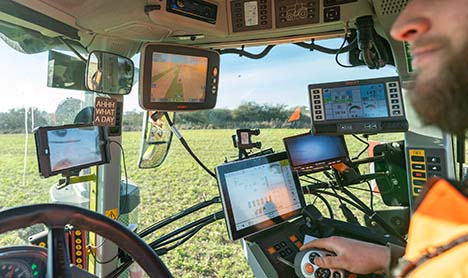
Crop Sprayer
A single machine can potentially
achieve 200 hectares per day, allowing
rapid progress to meet critical timing for
nutrient or crop protection applications as
soon as conditions allow. Each sprayer is
positionally aware and knows its speed of
travel, automatically adjusting flow rates
and isolating nozzles to prevent excess
application and overlap. Modern sprayers
are not only accurate but also better for the
environment and less expensive to run.
With 36m boom widths, tramlines
(wheeling’s) get spaced further apart to
reduce costly damage caused by soil
compaction. Other field equipment can
operate within factors of 36m (typically 6 or
12m), giving a degree of controlled traffic
farming (CTF). Of all the machines, the
sprayers make the most field visits, so are
key pieces of equipment in terms of CTF.
Combine Harvester
Efficiency is everything! One large combine
can harvest approximately 1,500ha per
season with a driver and backup team.
Compare that with an individual farm-sized
machine (inc driver/backup) which would
typically achieve a quarter of the output.
Add in GPS based yield mapping data,
which (in addition to other testing/sampling
activities) can accurately program seed rates
and nutrients for the following season.
To further boost output and reduce losses, a
12m (40ft) wide flex-draper header is fitted
to each machine. Engineered to float/follow
ground contours to pick up all crops,
including any that are laying flat, sending
them into the combine feeder heads-first
ensuring threshing performance is truly
maximised, whilst also leaving an evenly
trimmed stubble for simpler field workings
that follow. These beds are also more user-
friendly and widen the operational window
across early/late damper conditions.
An extended unloading auger allows the
attending tractor/trailer (floatation tyres
fitted) to travel along 12m CTF tramlines.
Fixed Plant & Buildings
Not as exciting or striking as a flashy new
piece of field equipment, and perhaps
because of that, investment in fixed plant
and storage often goes unnoticed, but it can
add significant operational efficiencies. Grain
dryers are a prime example (see the large
metal box with 3x upper outlets).
They allow activities to get ahead instead of
waiting on the weather to dry crops until fit
for harvest, or worse, paying extortionate
fees when delivering produce above contract
moisture levels directly to merchants. Having
proper drying, cooling and storage facilities
avalable is like running a virtual combine,
particularly in years with bad weather, which
unfortunately, seem to be becoming more
frequent (certainly during harvest).
Each drying plant can normally keep
pace with the output of a large combine,
yet, with competent management and
extended working hours, can actually
intake from two of them.
Additionally, it is worth noting that crops
can be stored for extended periods of time
(so long as they remain sufficiently dry/cool).
Having ample capacity can be useful if
deciding to defer sale when commodity
prices look likely to increase (assuming
cashflow allows).
Moving Forwards
Stronger Together
Historical data shows that since the end of
World War II, UK farming has on
average achieved a threefold increase in
wheat production, largely resulting from
advances in science and tech efficiencies.
However, despite the increased productivity
levels, costs have also risen markedly, whilst
in real terms, wheat in 2025 is worth four
times less than in 1945. Farmers no longer
receive a fair slice of the cake and haven’t
done so in a while. Food has become a
global commodity with consumers
demanding more for less (with little
regard for production standards/quality) yet
farmers face market volatility (for inputs
& outputs) like never before.
As it stands, farms, and their supply chains,
are finding it nigh on impossible to survive.
The root of the problem relates to irrational
legislative decisions: Post-Brexit abolition of
subsidies, draconian regulation, imbalanced
trading agreements, and the uncertainty
surrounding stewardship schemes; these are
all factors contributing to mounting
industry-wide viability pressures.
Despite their best efforts, farmers across the
country are being forced to reconsider their
generational livelihoods. Some decide to
struggle on because it’s what they do,
supplementing their income by other means
or diversification. Others have already sold-
out to corporates bodies, many of whom
primarily look at the land as an investment
or tax offset rather than for the value of food
production or care of the countryside.
Have you ever considered
contracting out your farm?
It may not be a solution for every business,
but entering a contracting arrangement can
ease the pressure and offer a host of benefits:
- Retaining ownership/trading status
and receiving a fair income. - Freeing-up working capital through
the sale of assets. - No day-to-day responsibilities and
reduced administrative burden. - An increased depth of expertise,
agronomy & operational ability. - Utilising machinery that is often
more suitable, larger & efficient. - Equipped to work in a wider range
of conditions. - Make savings through bulk
procurement of inputs. - Lower risk by benefiting from
group crop marketing power. - Receive extra income from farm
assurance/compliance schemes. - Capability for drying and storing
crops at lower rates.
With a proven track record for establishing
and nurturing long-term client relationships
by creating tailor-made agreements that
work for all stakeholders, Conant Farming is
interested in considering suitable expansion
opportunities, tackling the challenging times
farming presently faces:
Please get in touch for an initial,
confidential, and no obligation conversation.
assurance and also encourages all farms
to become LEAF members.
